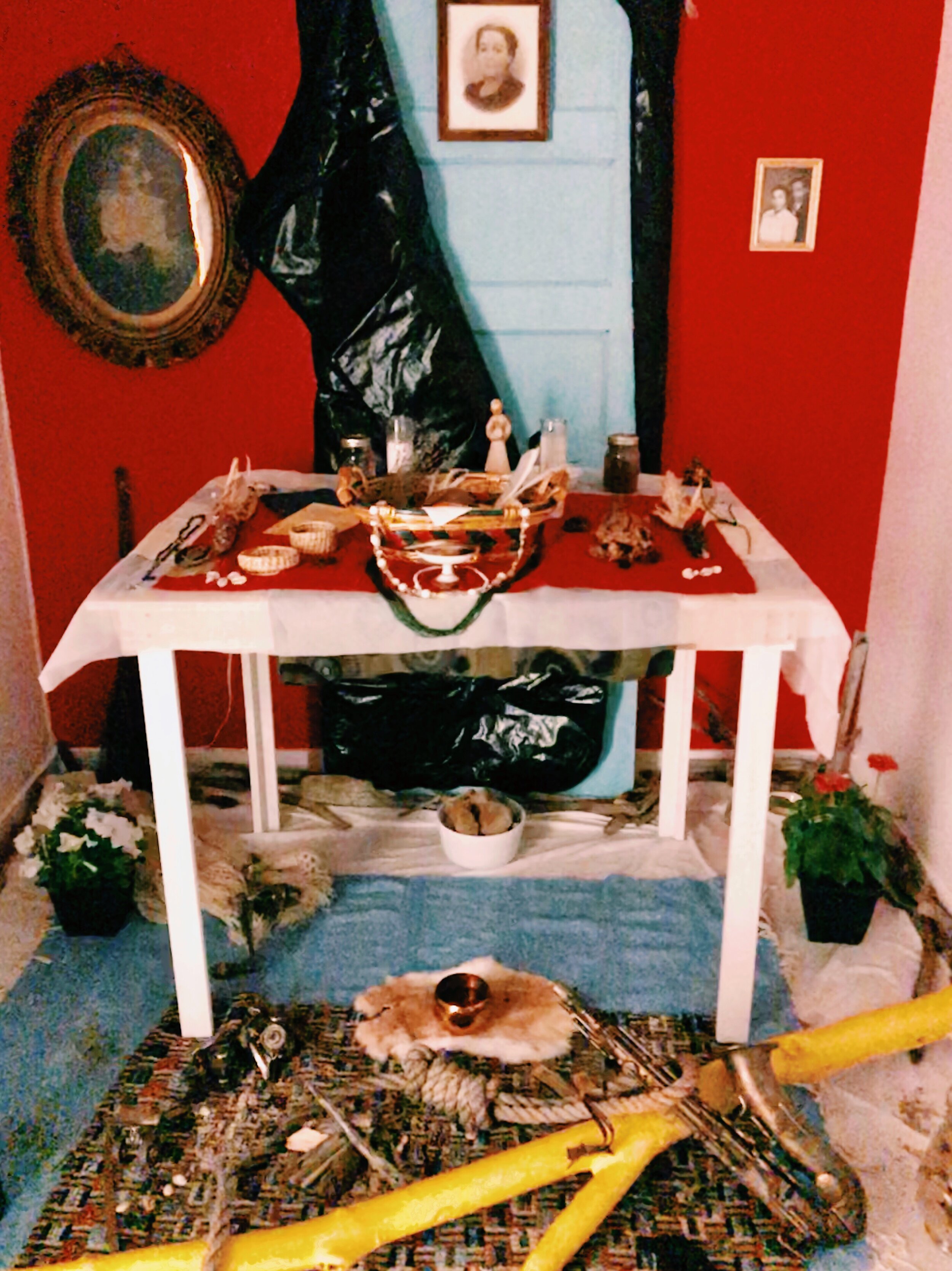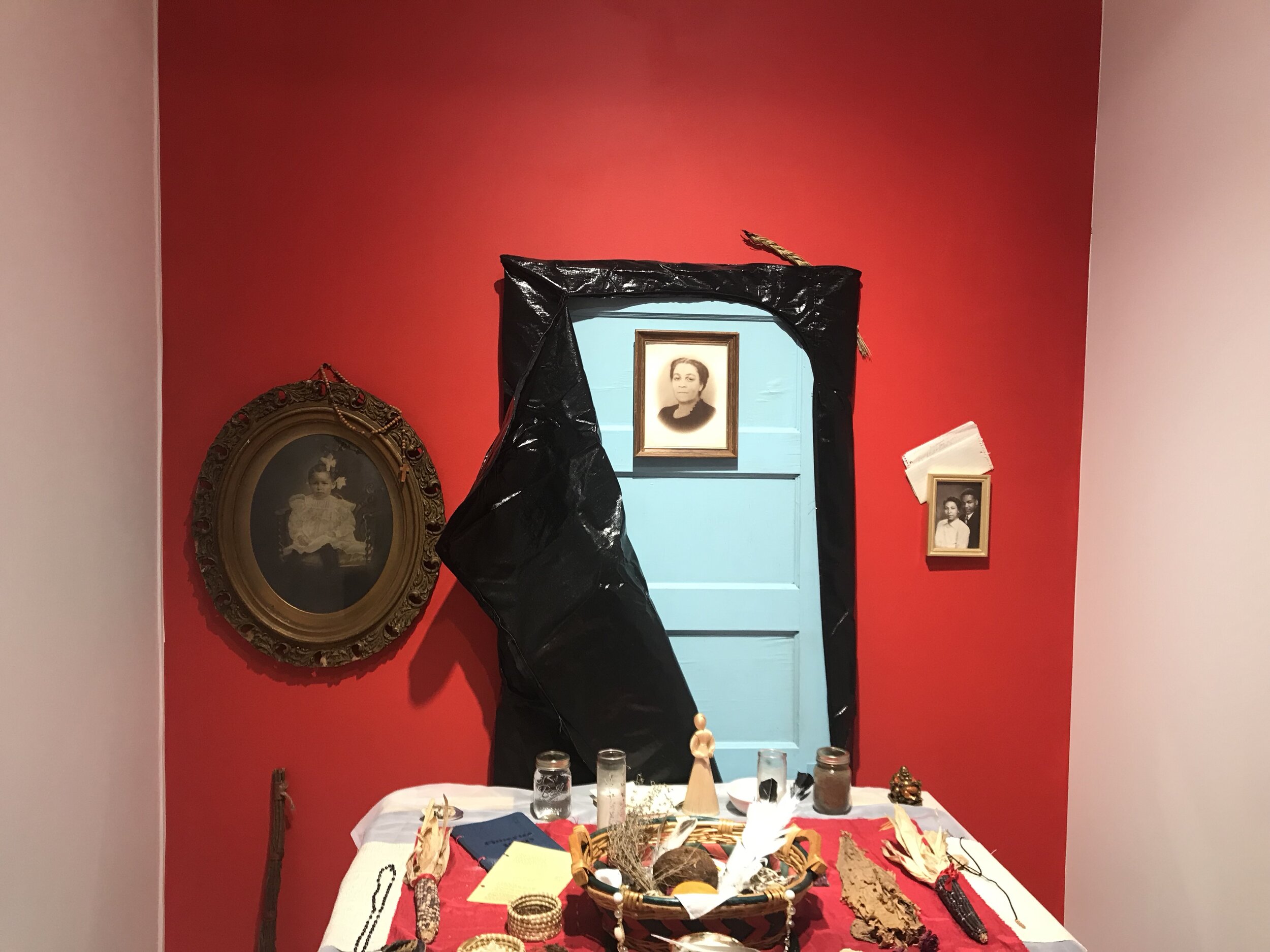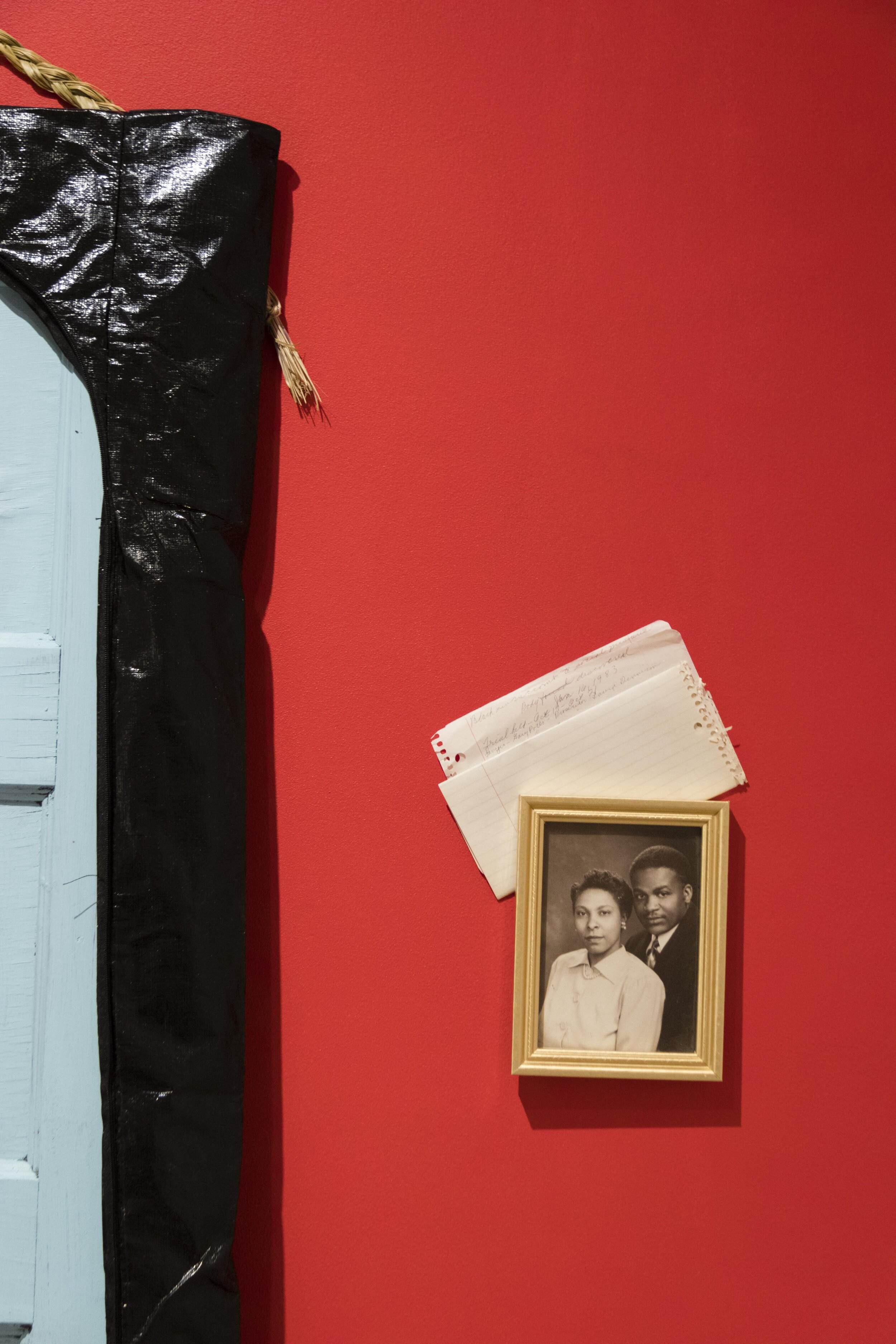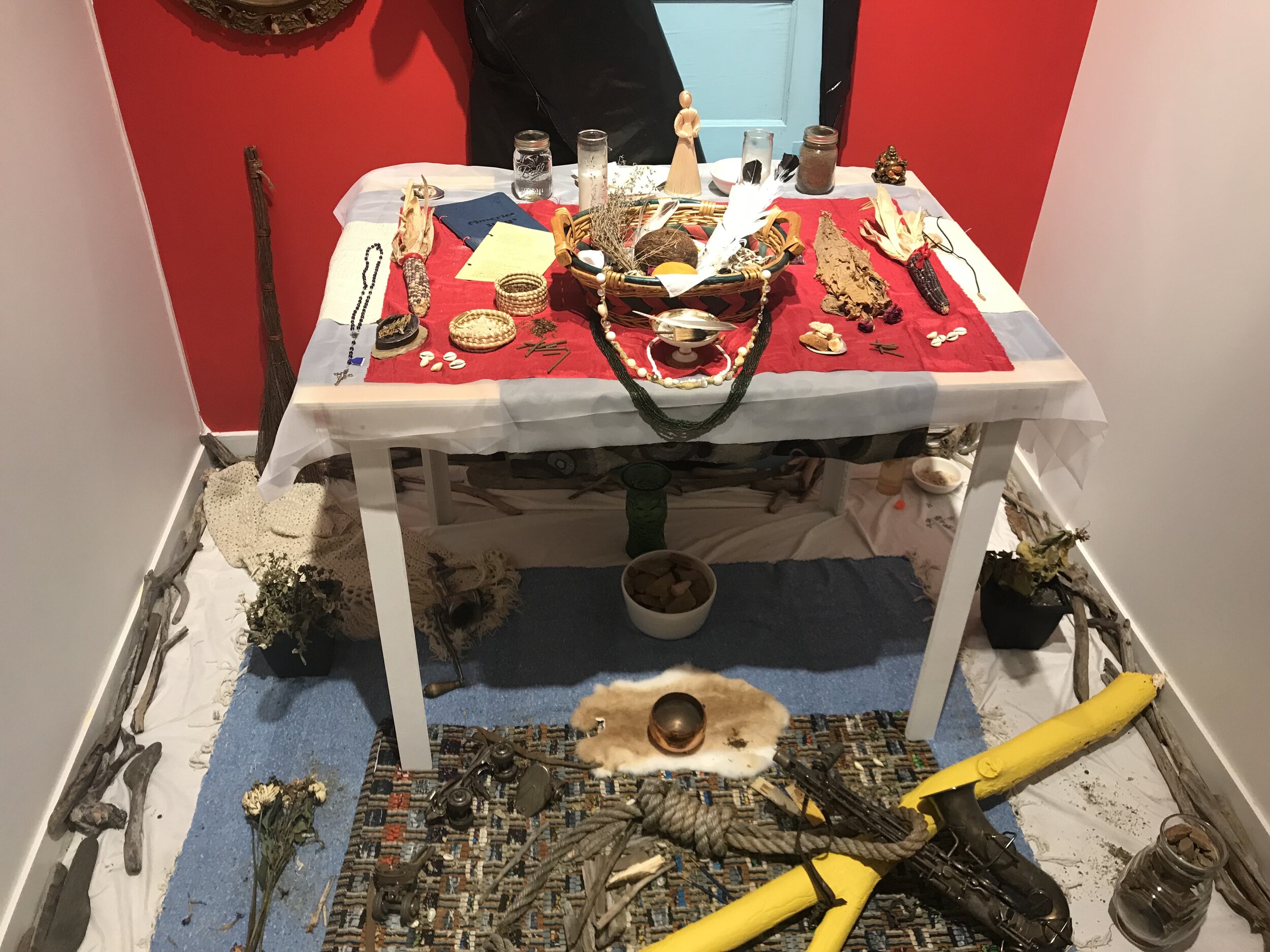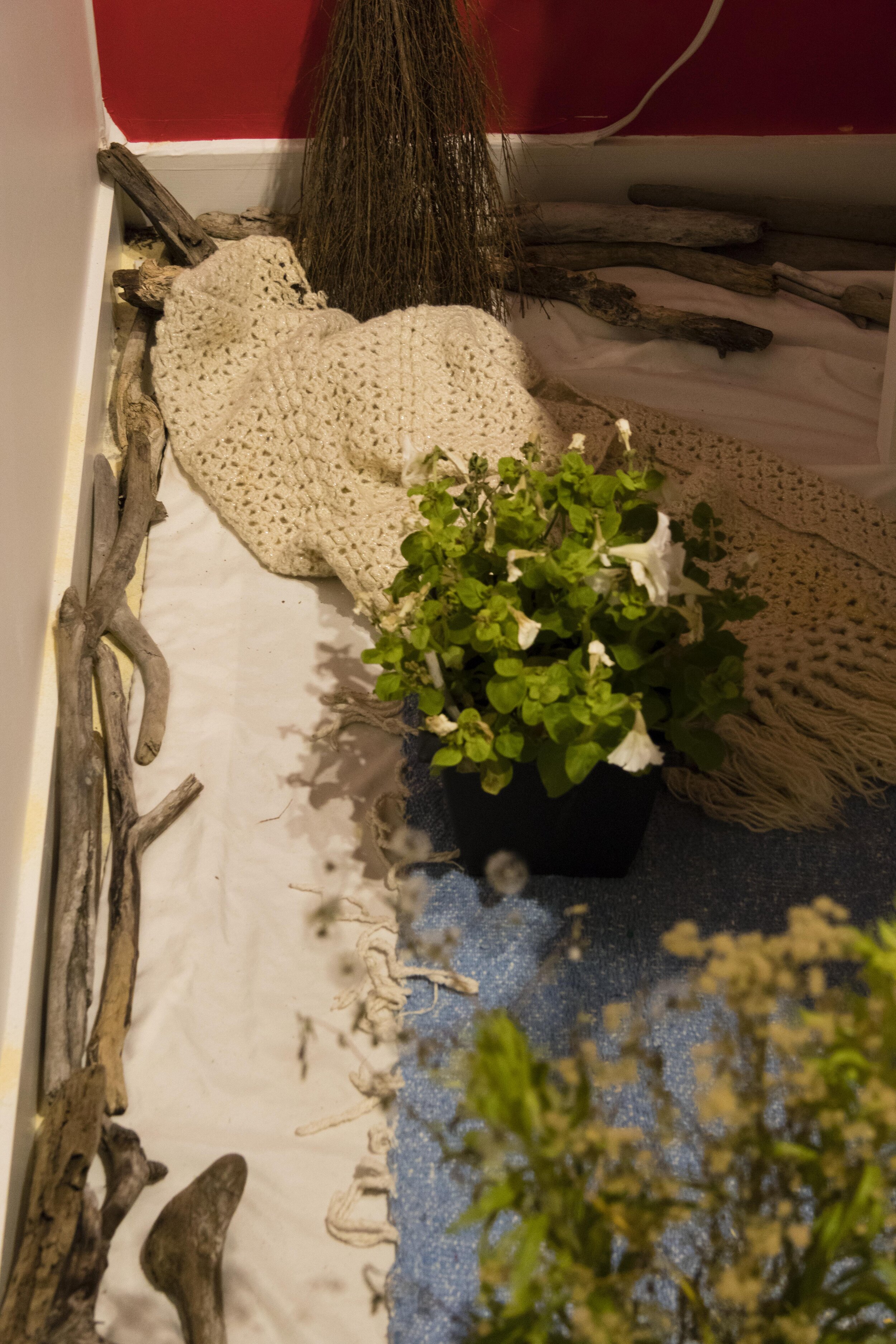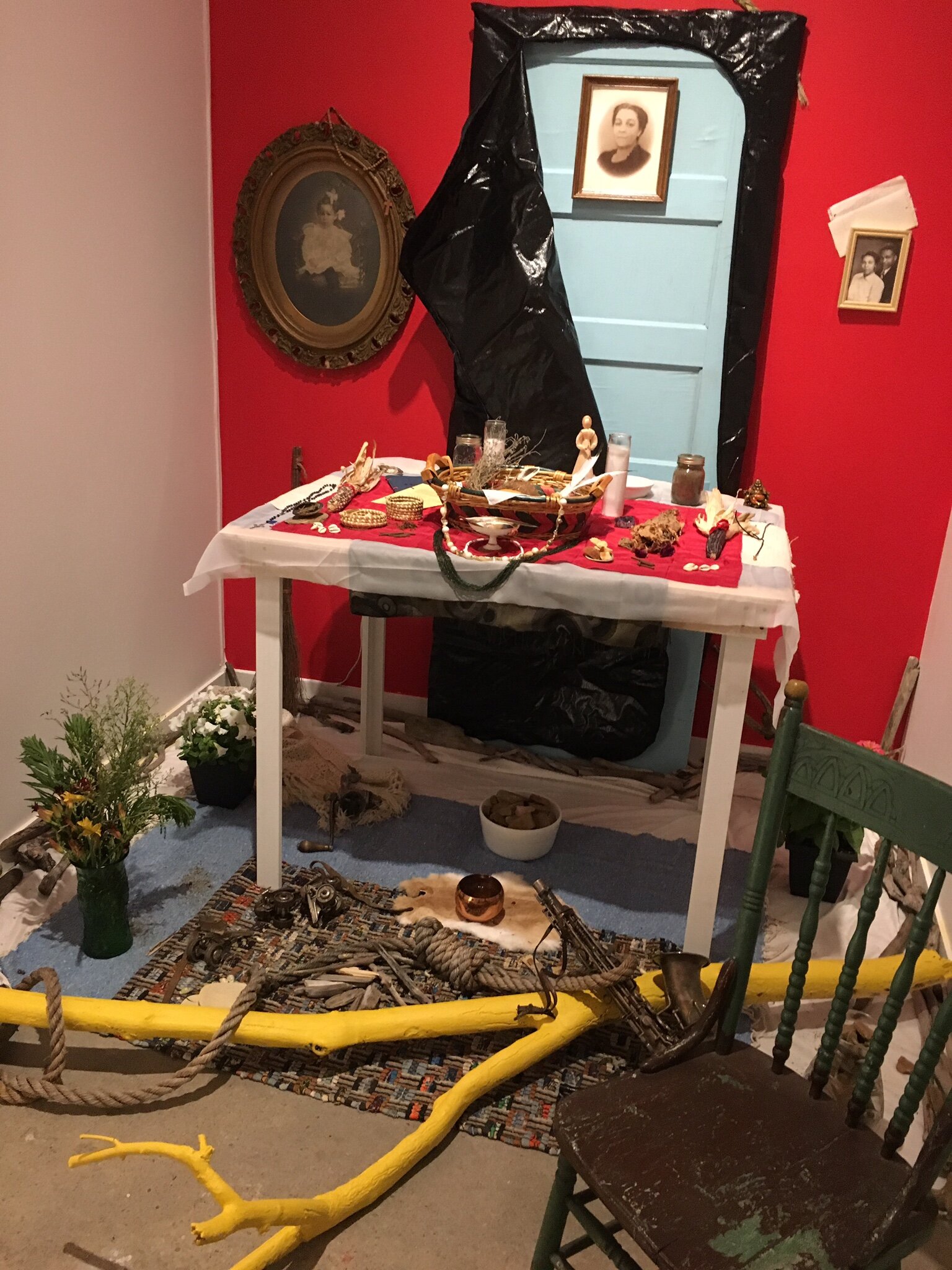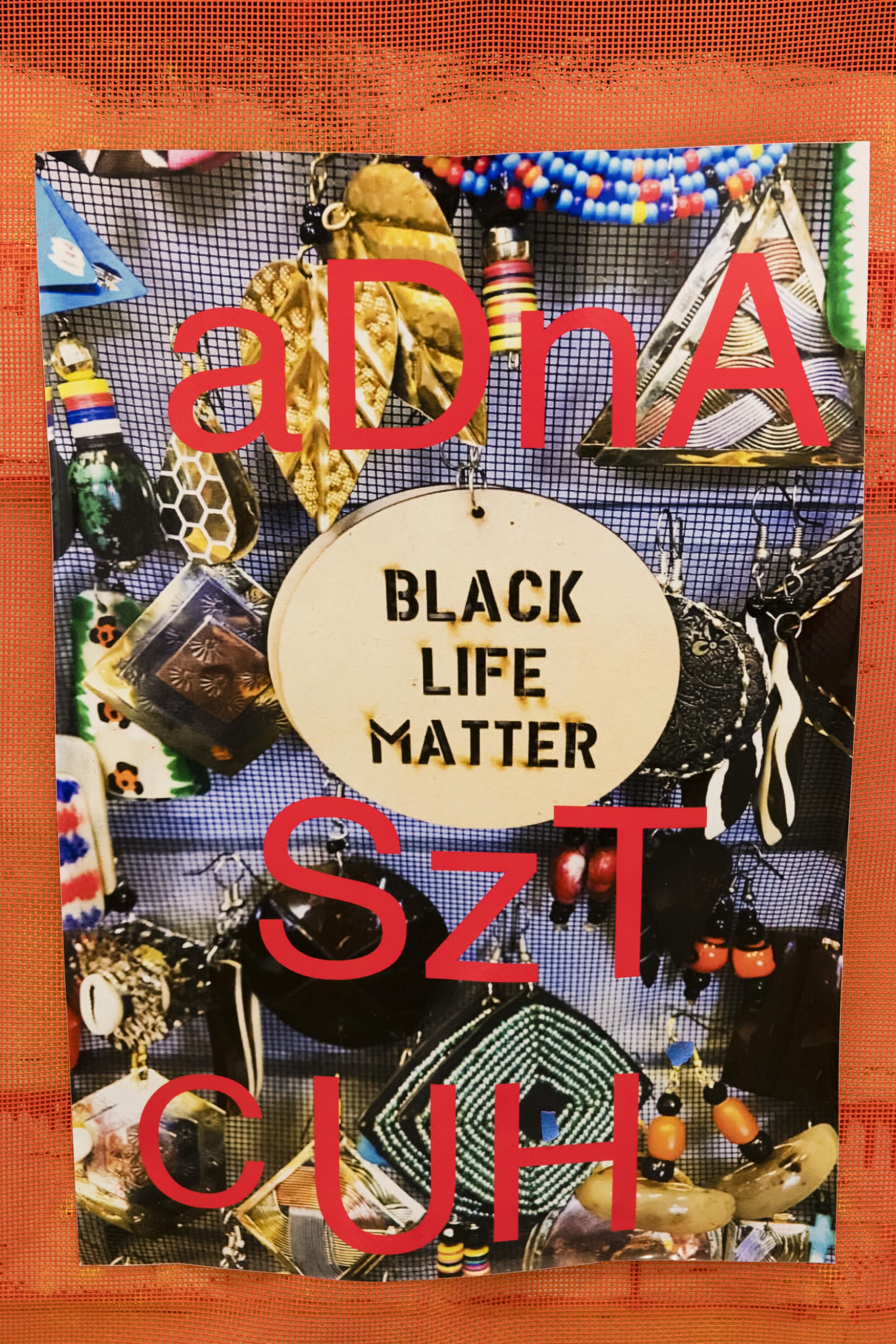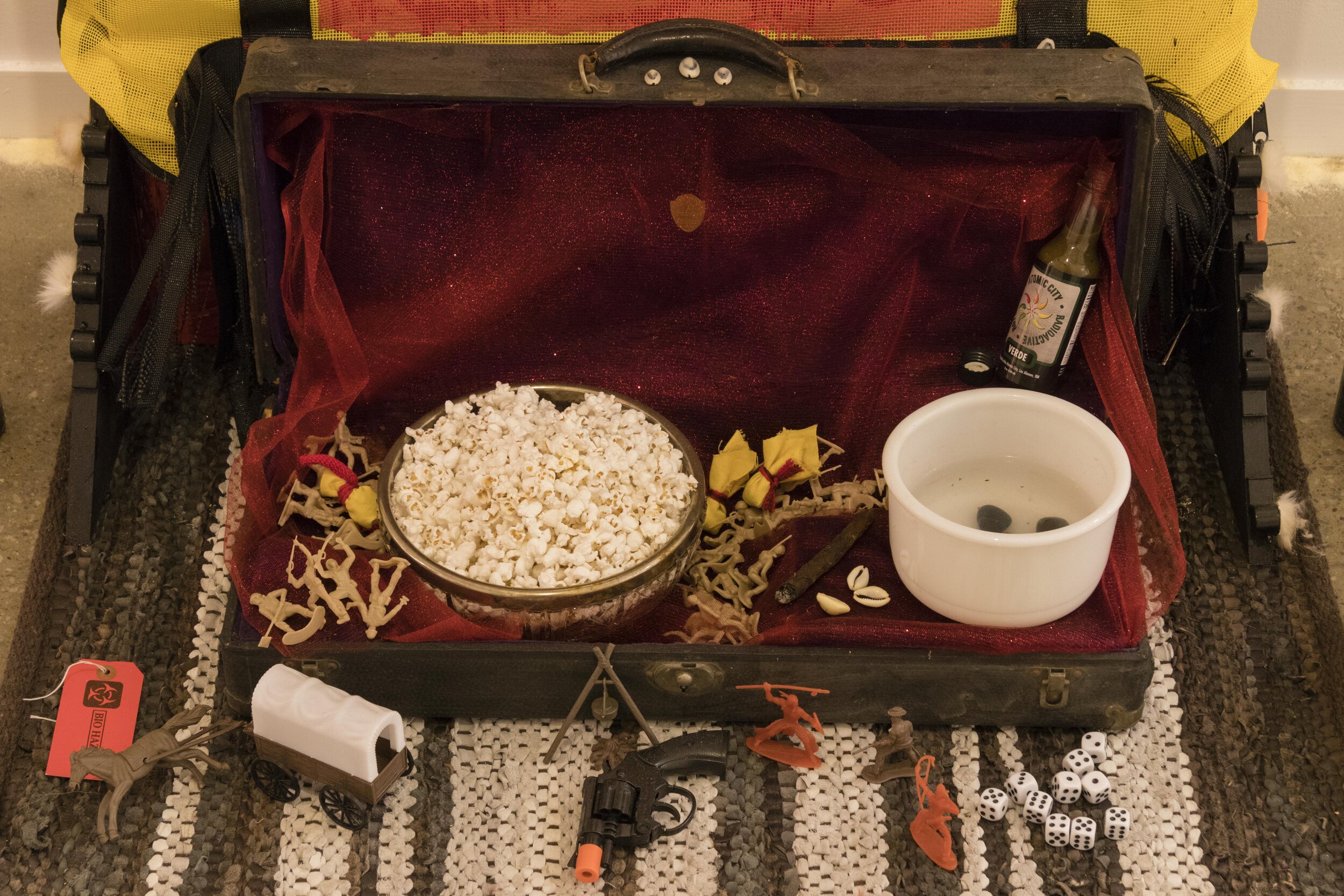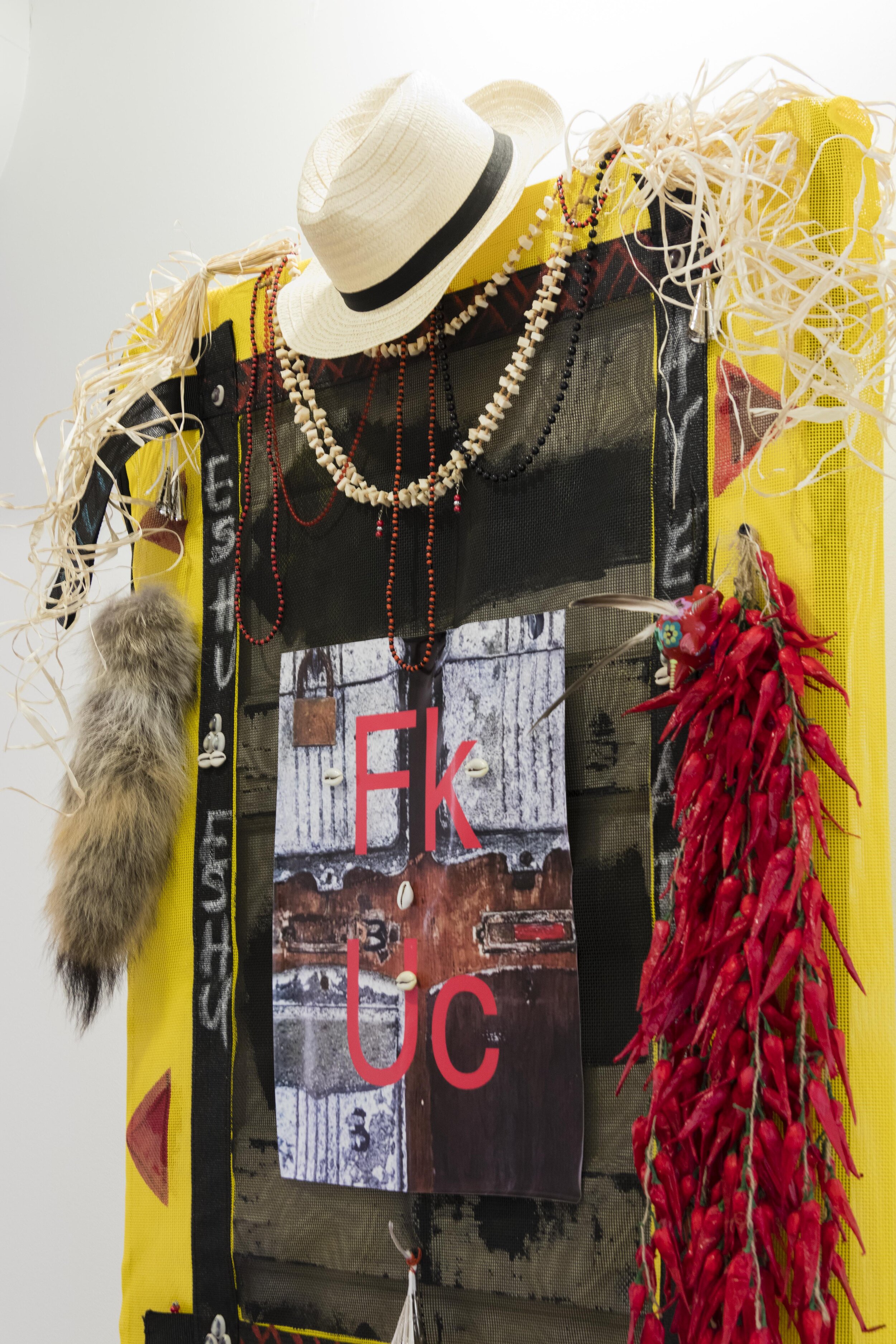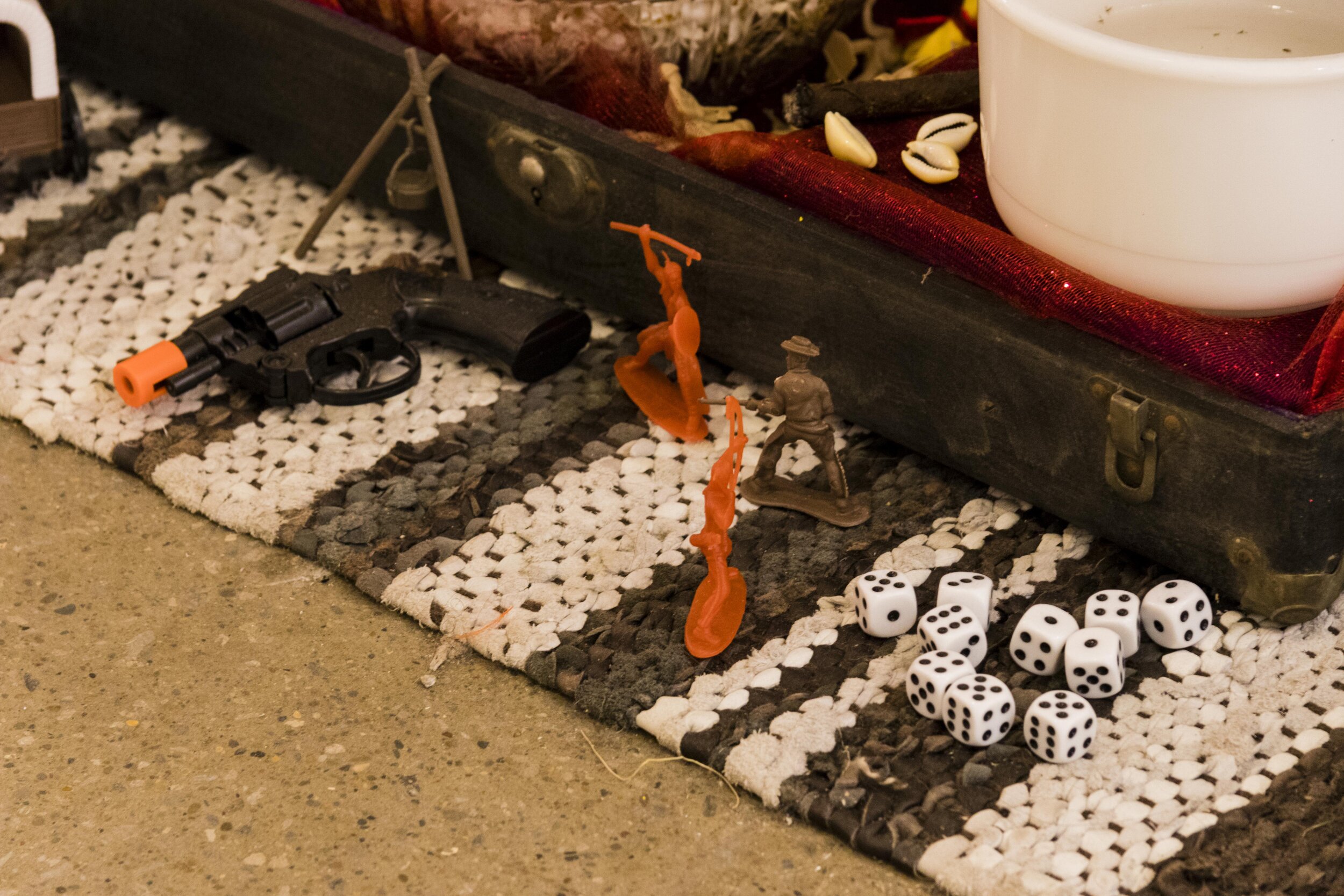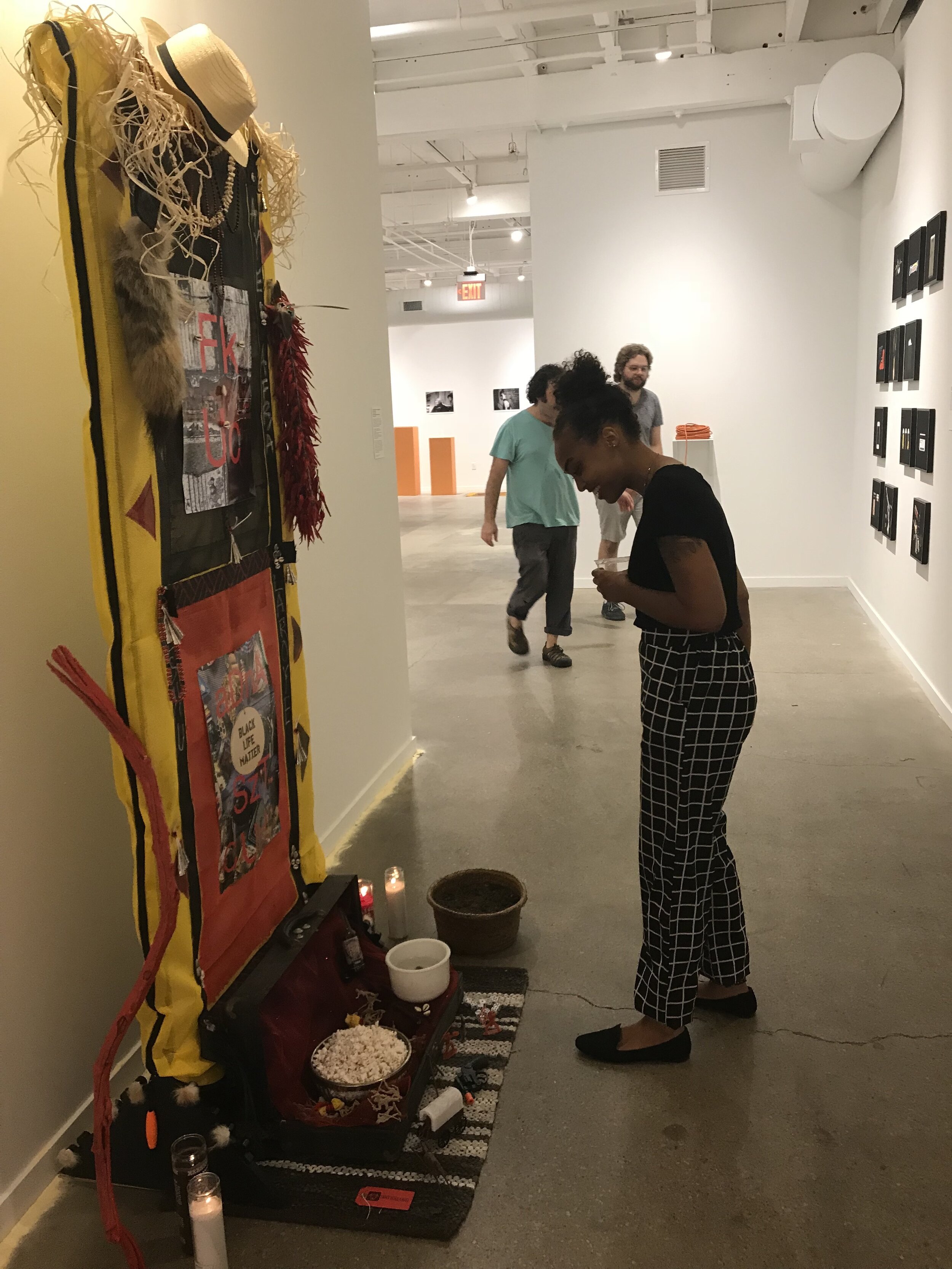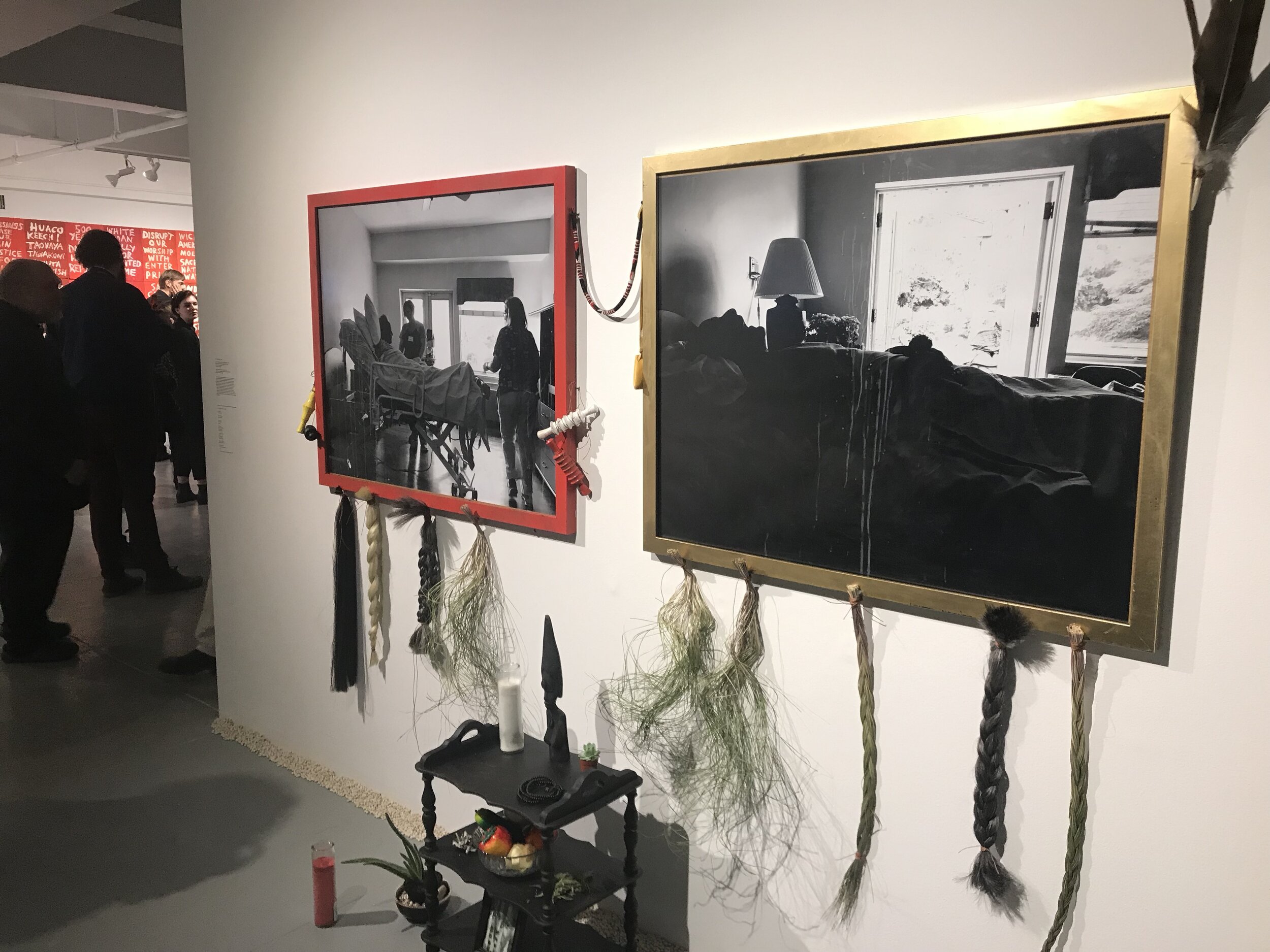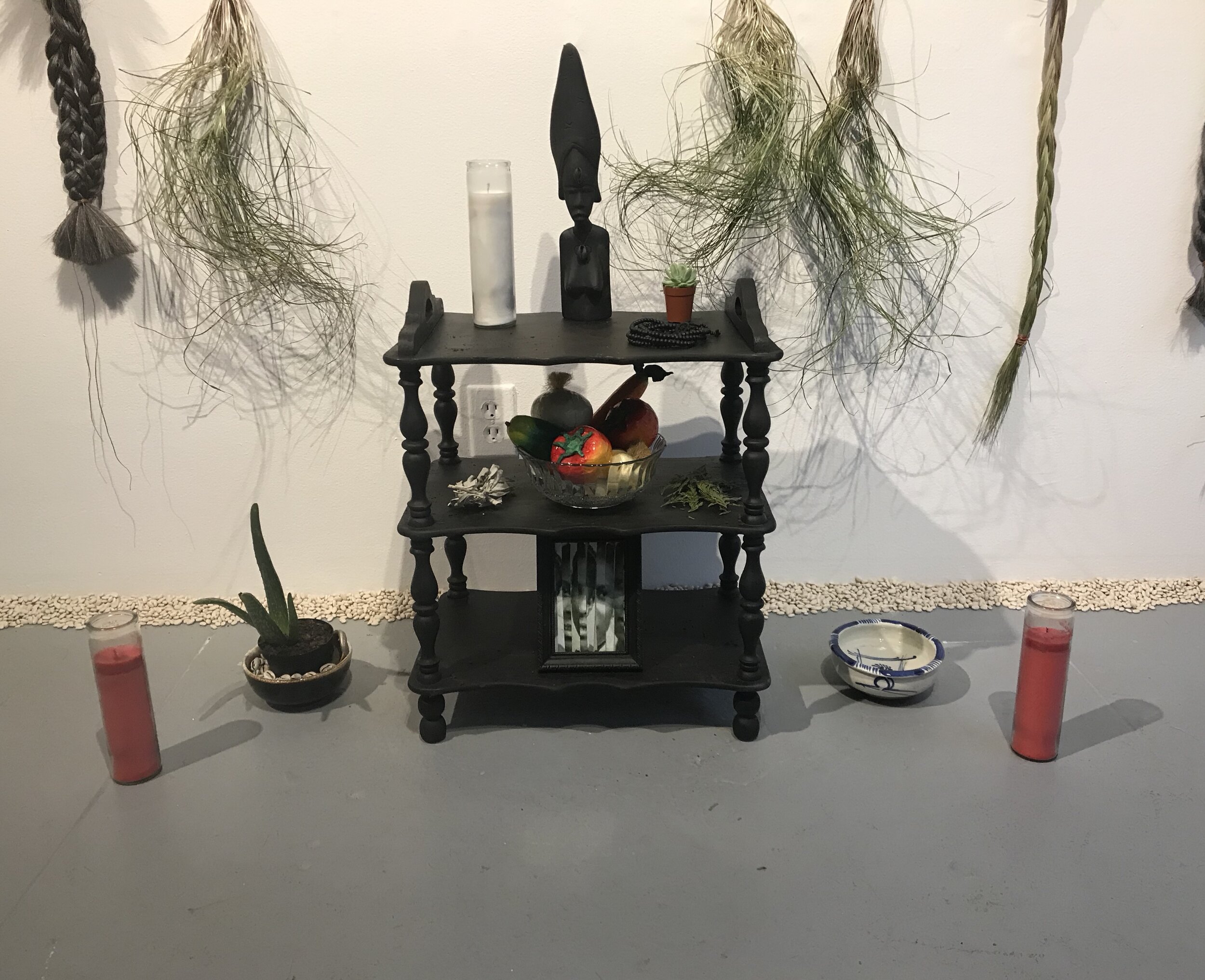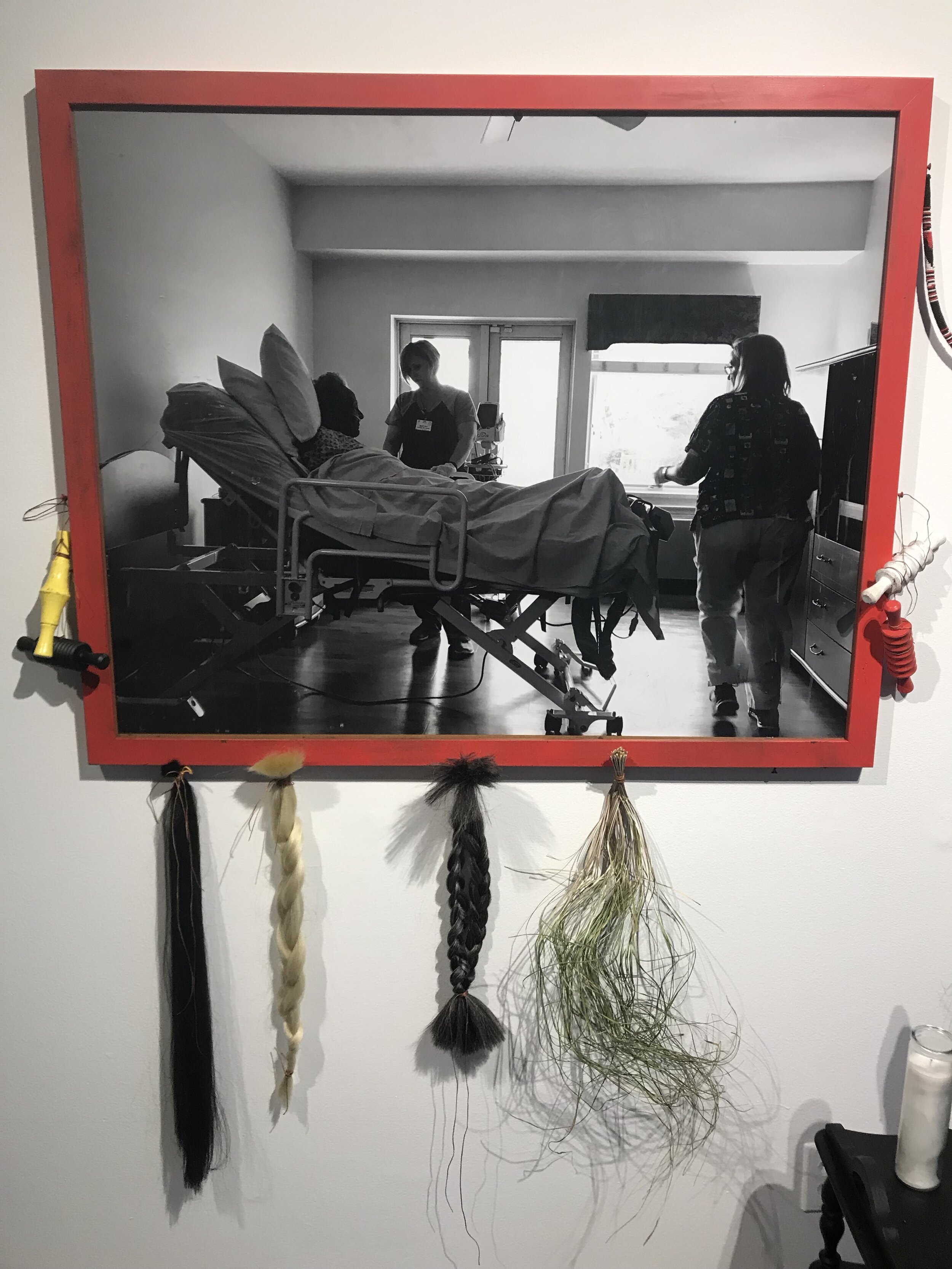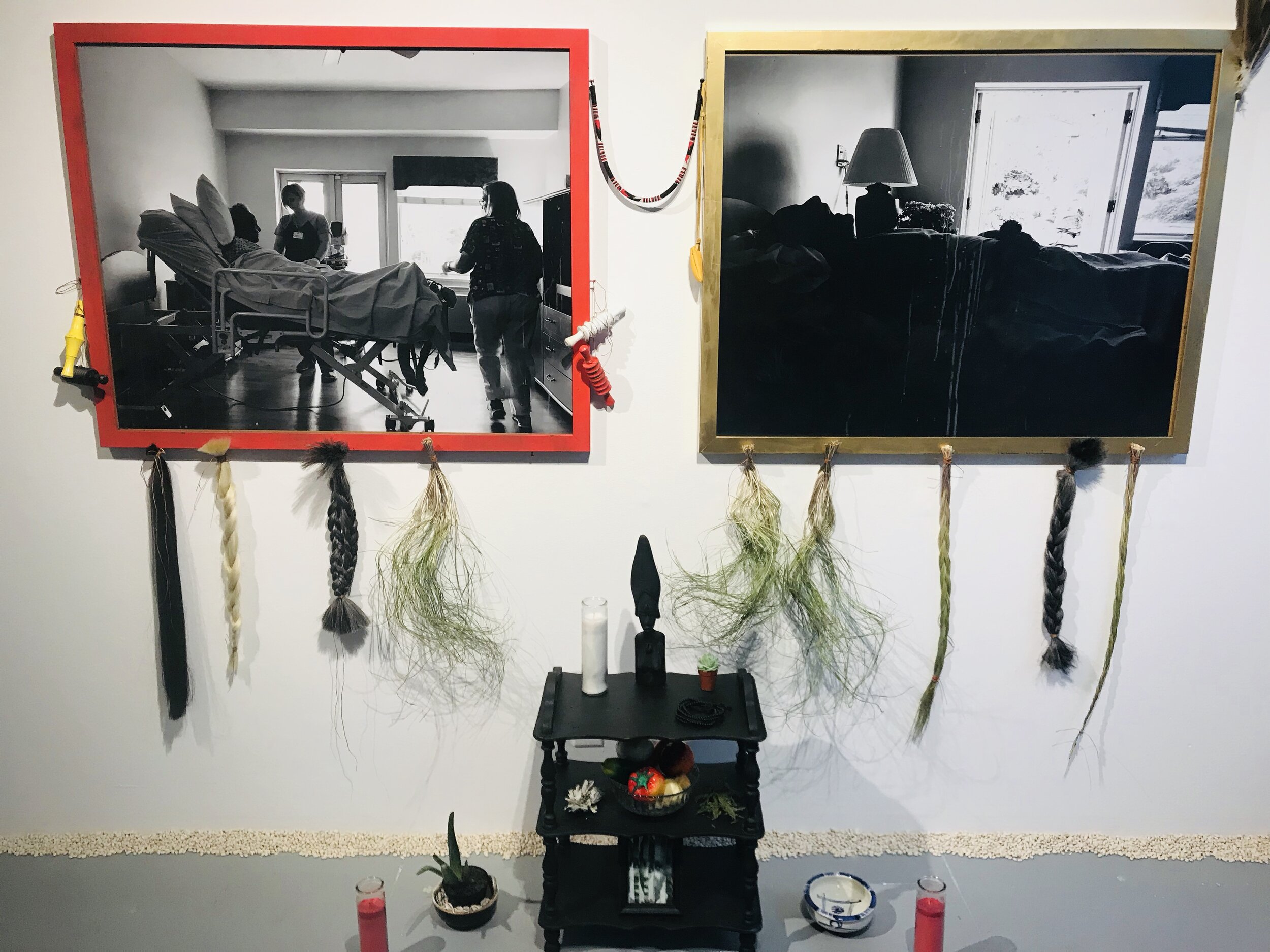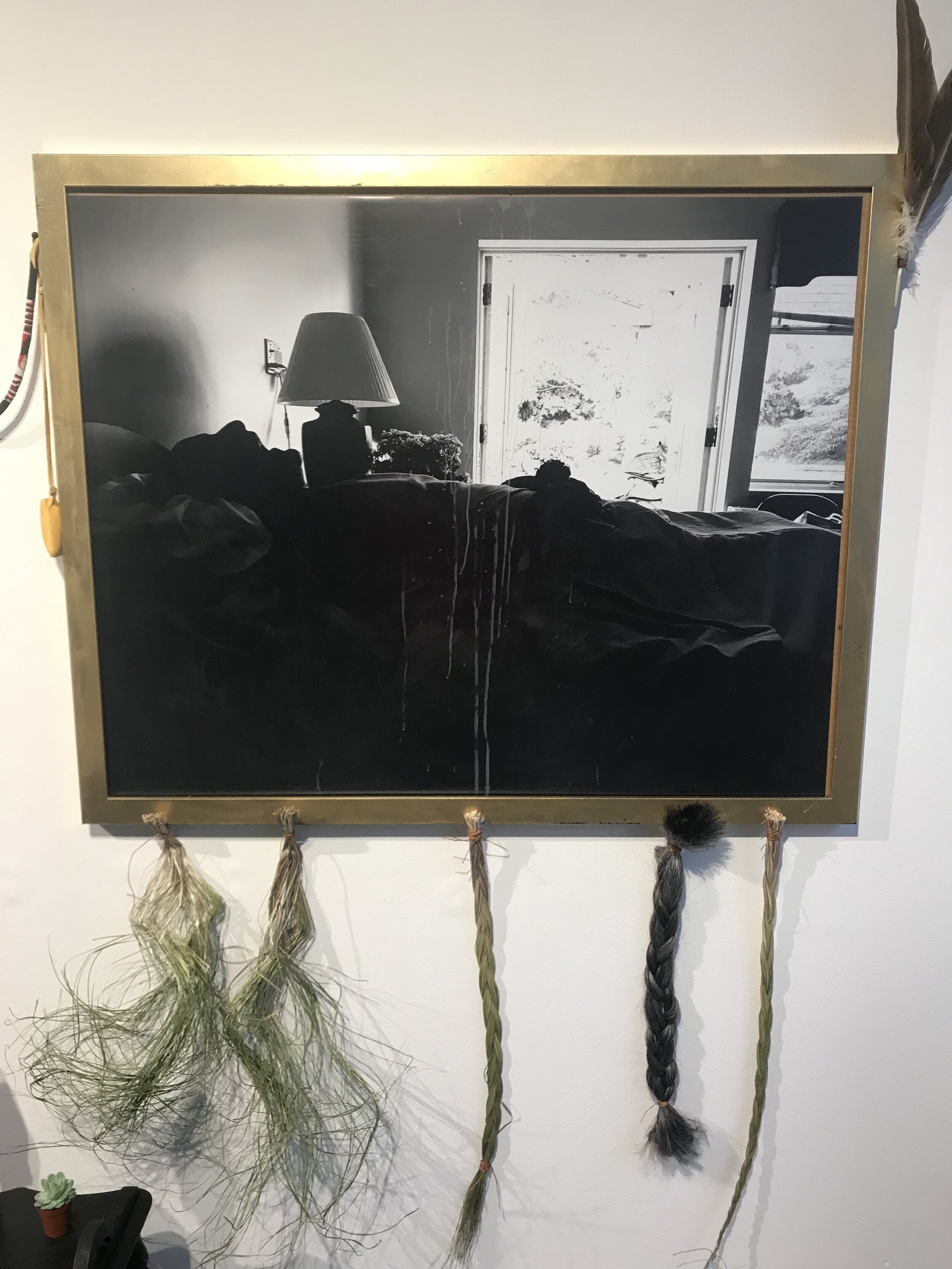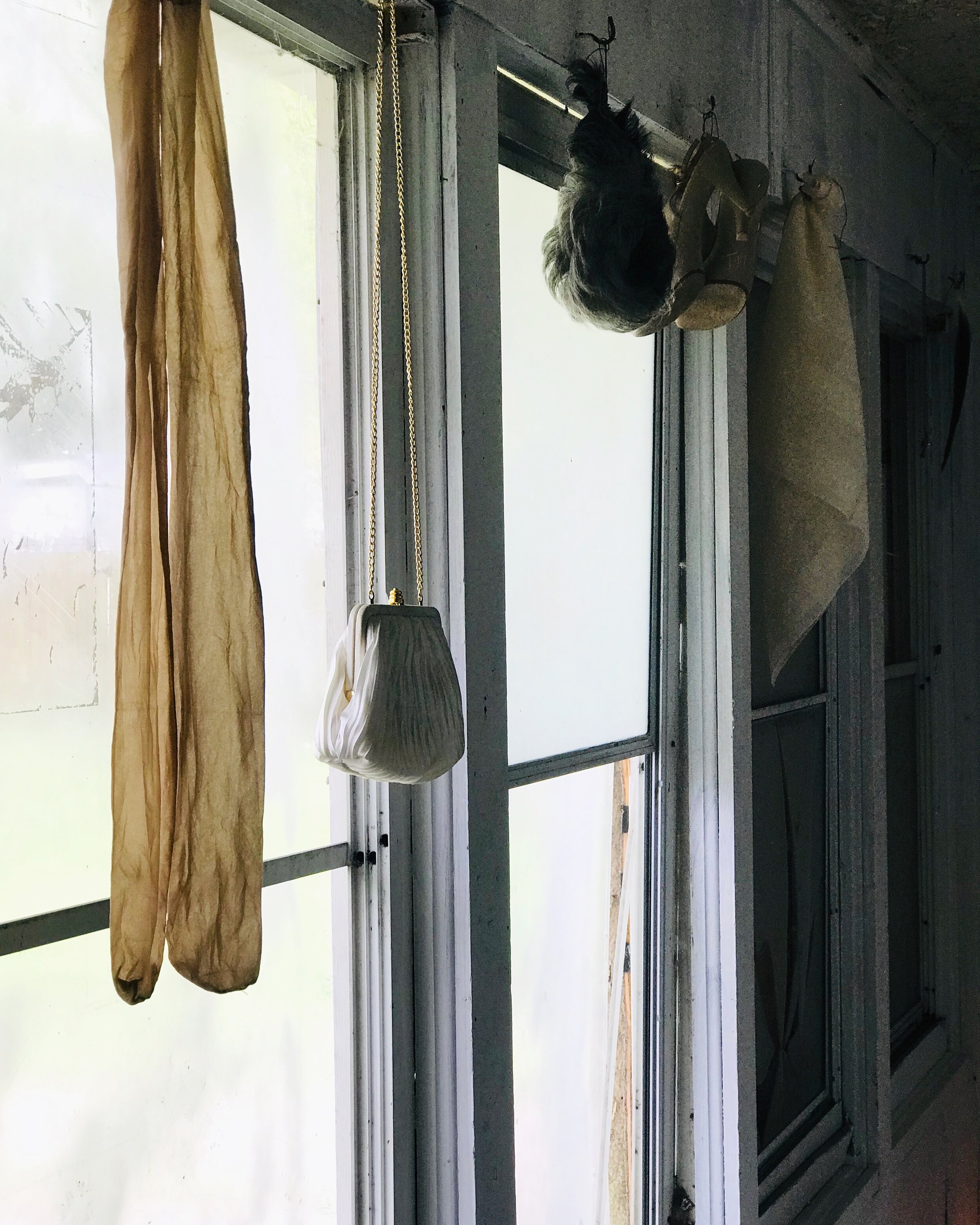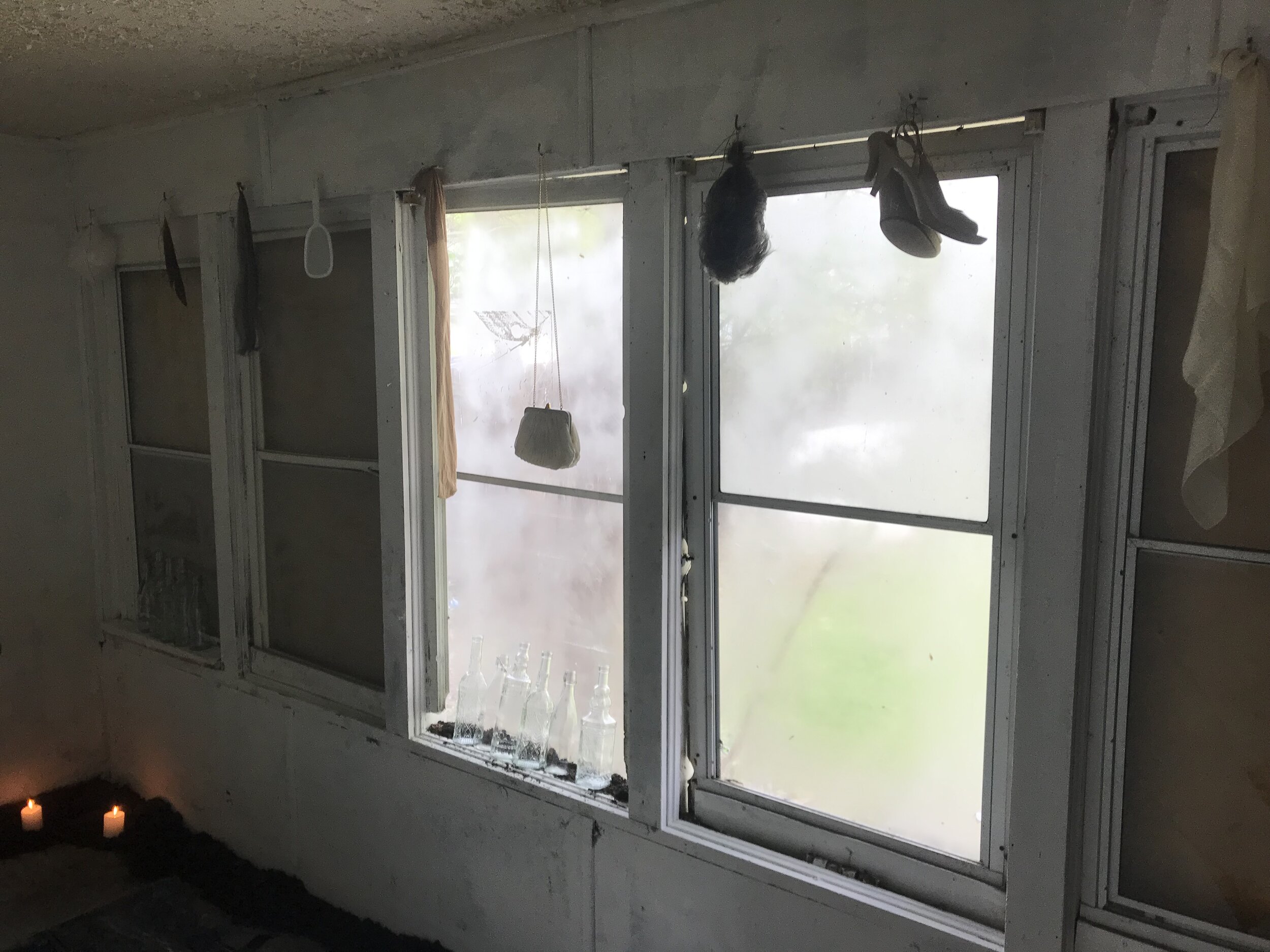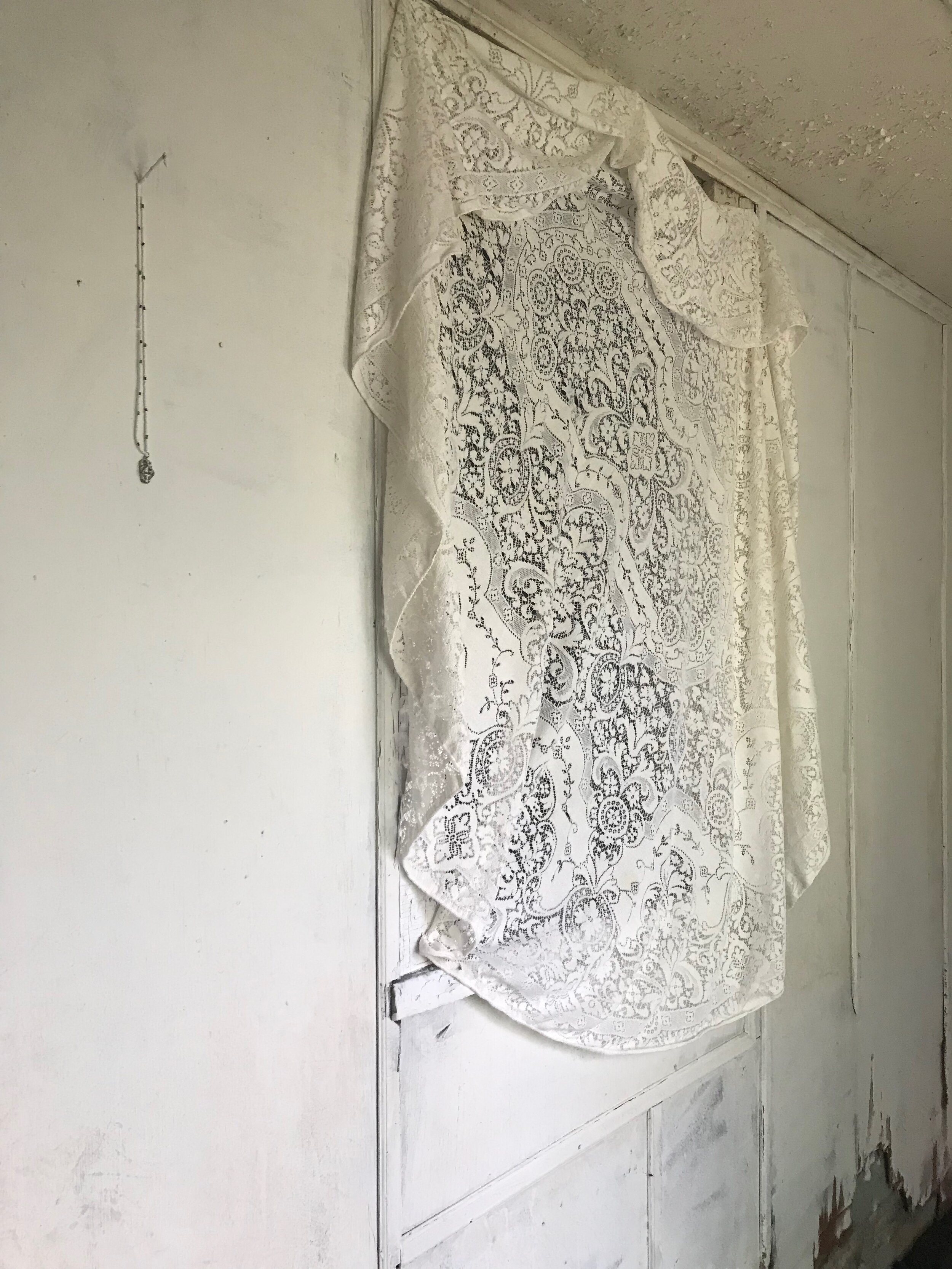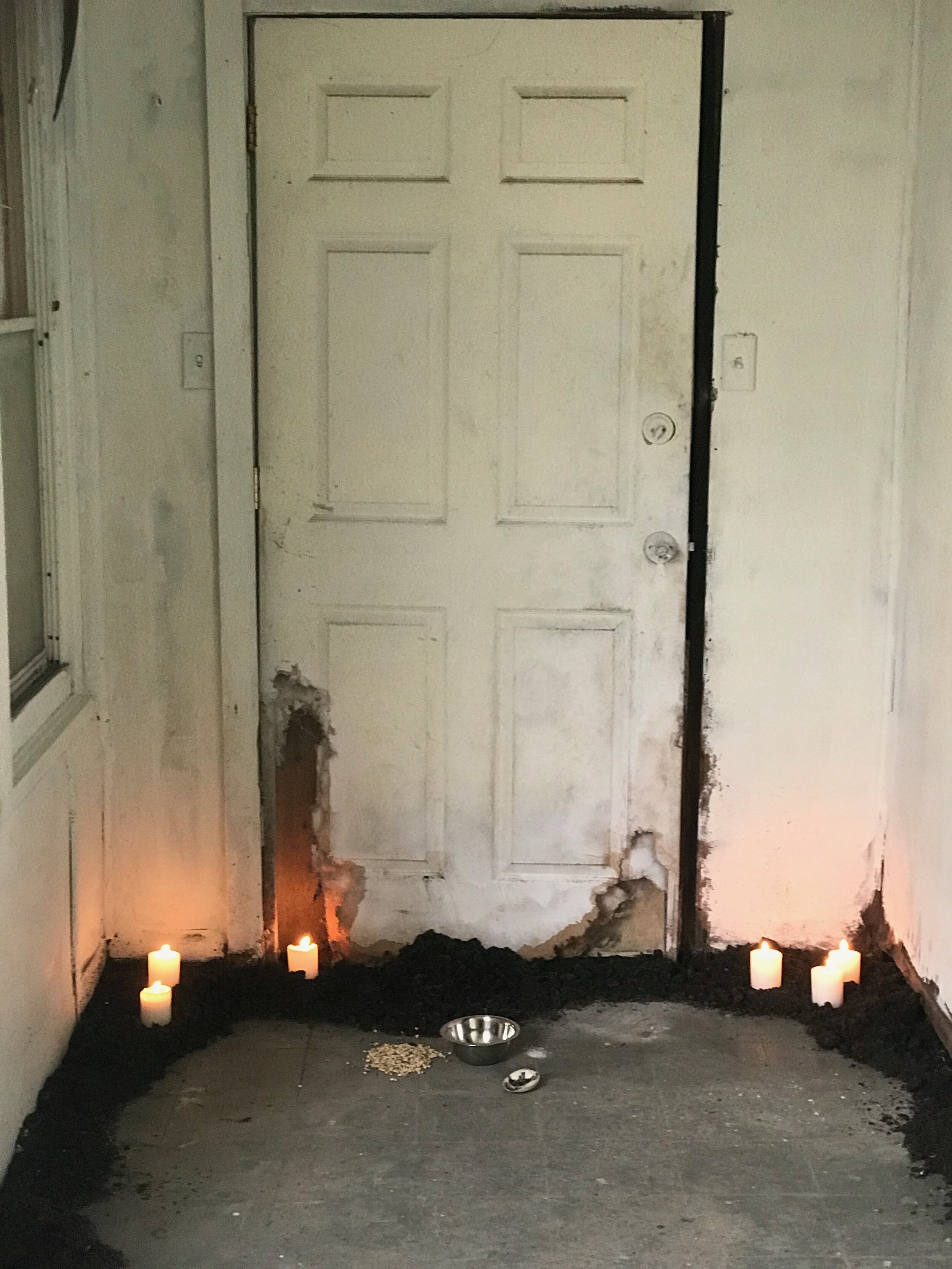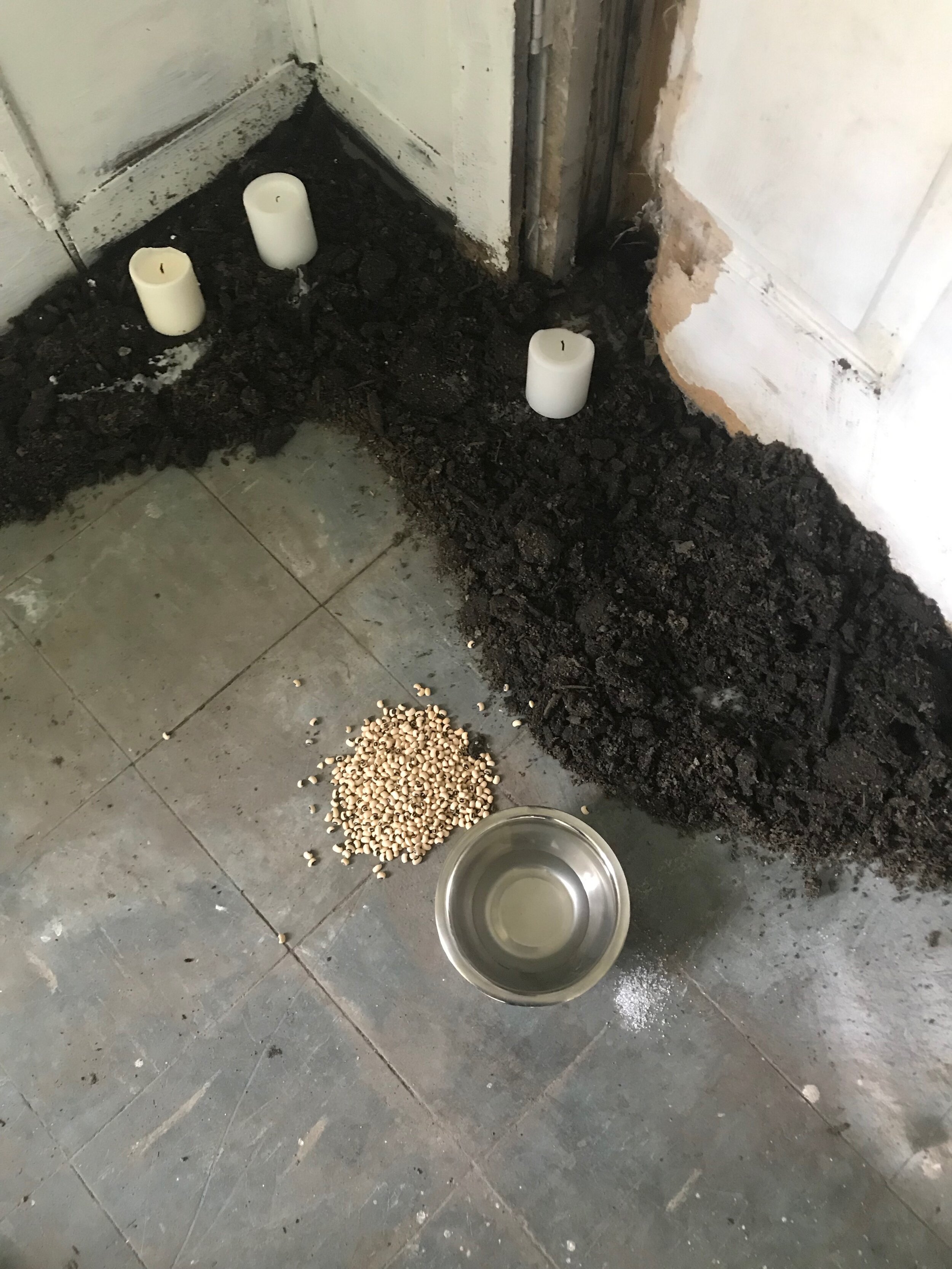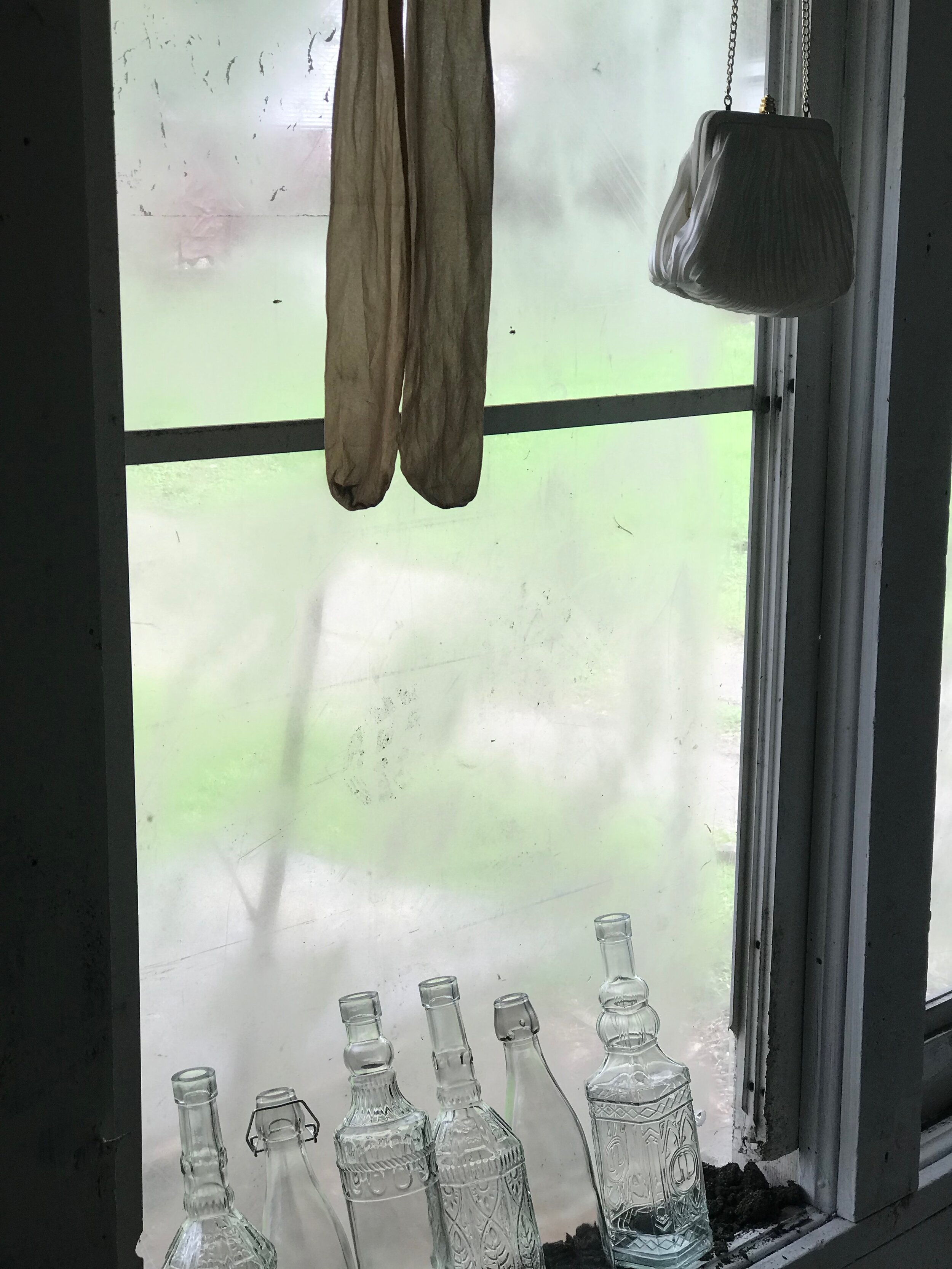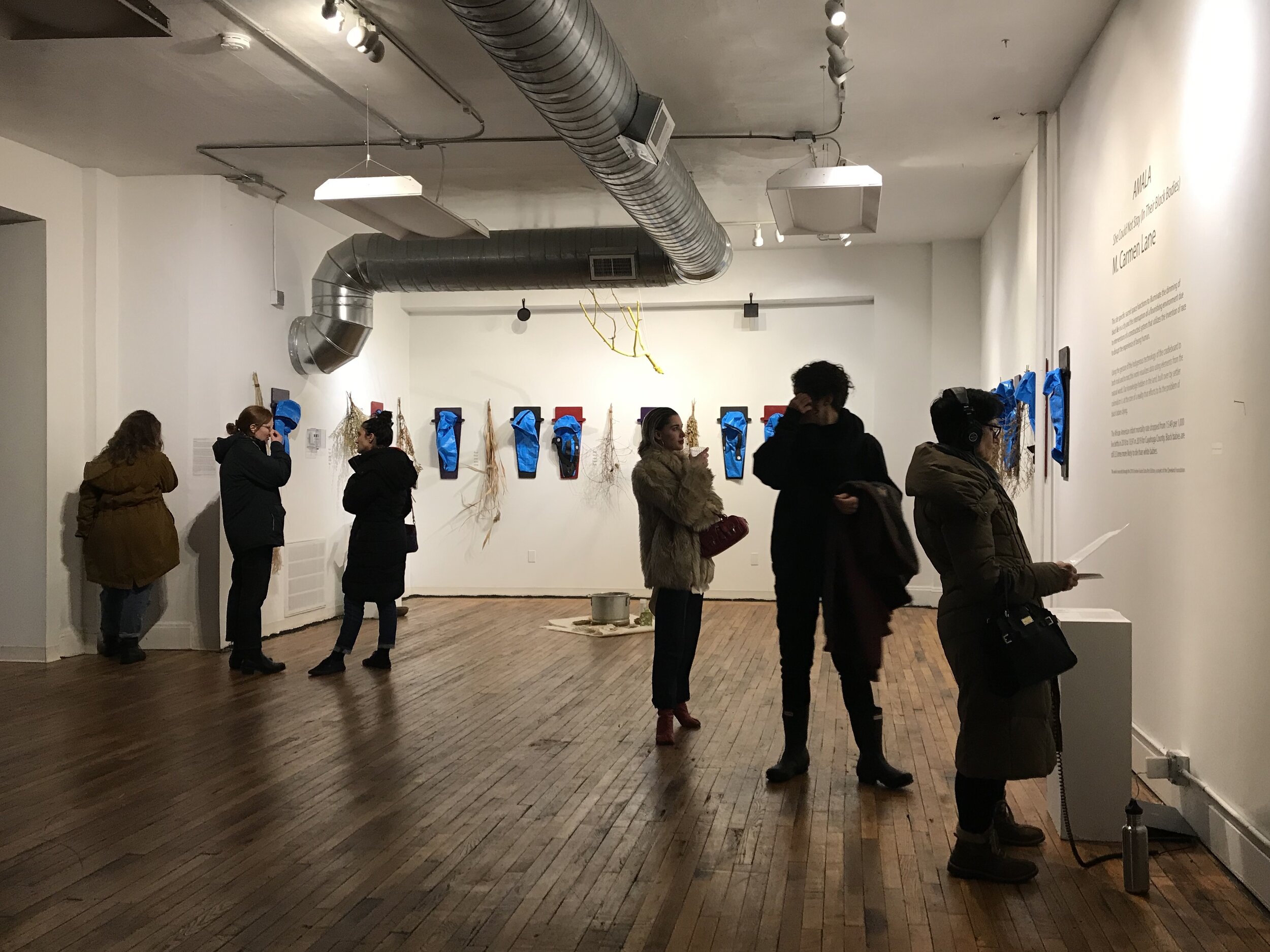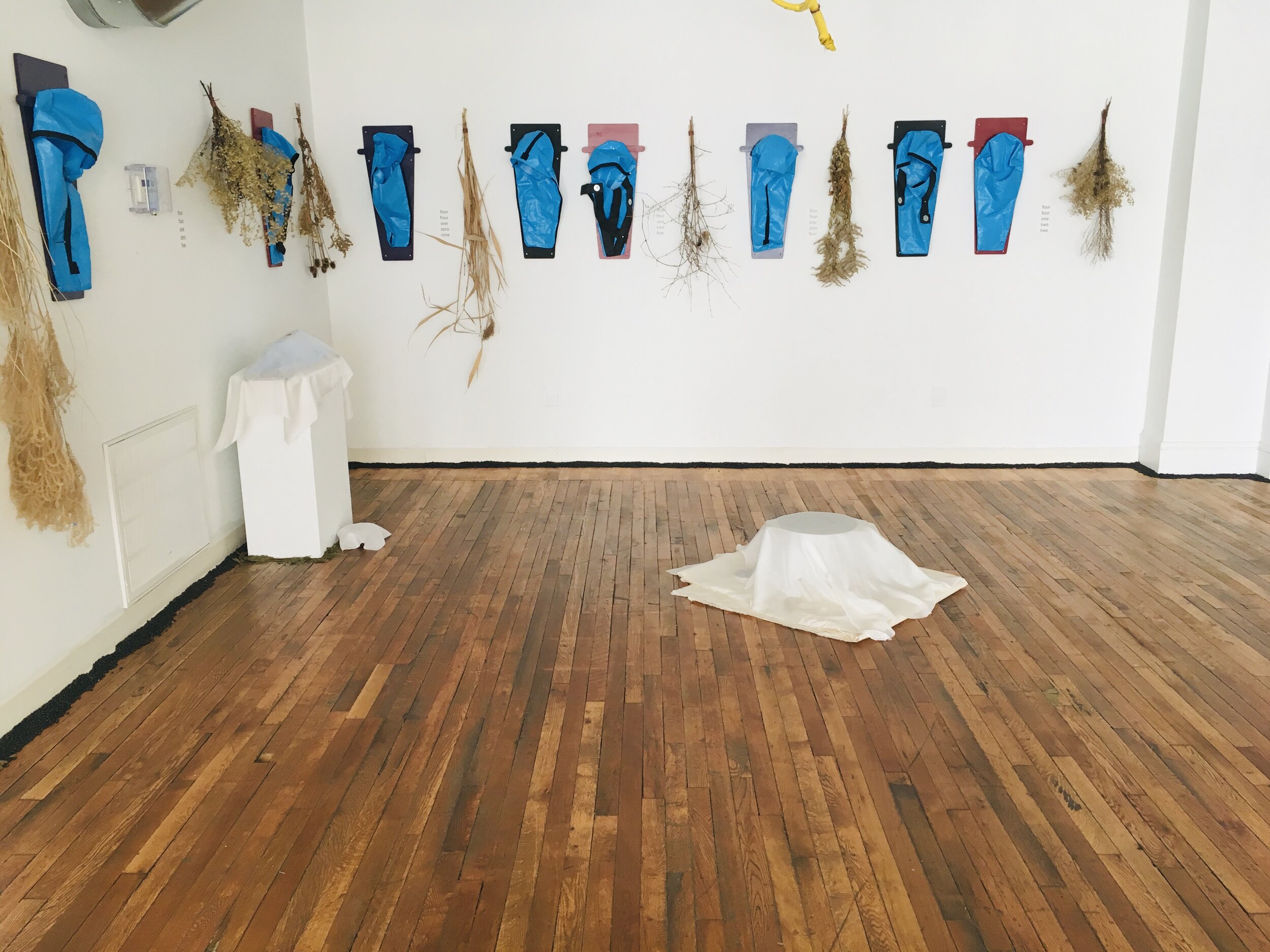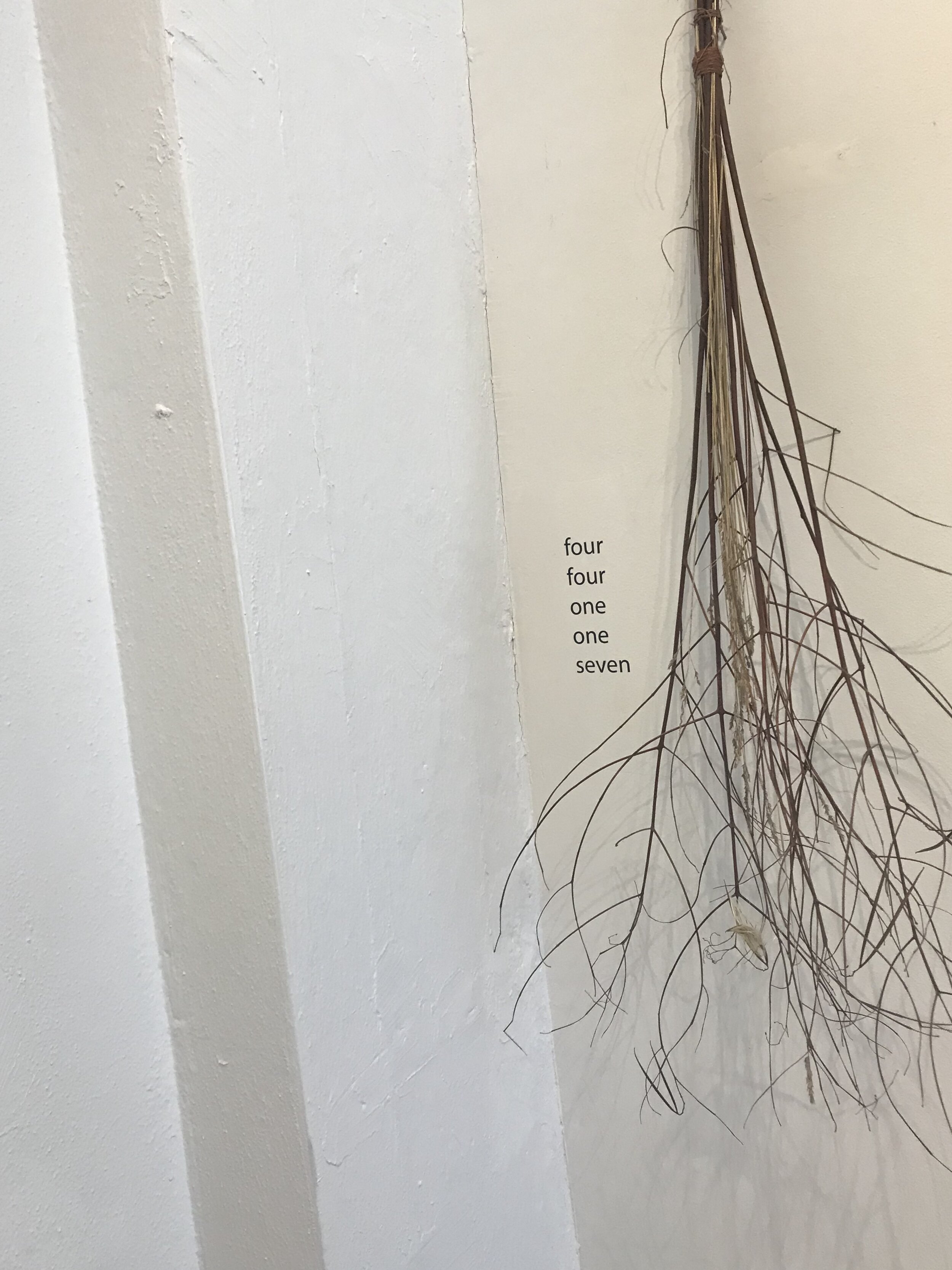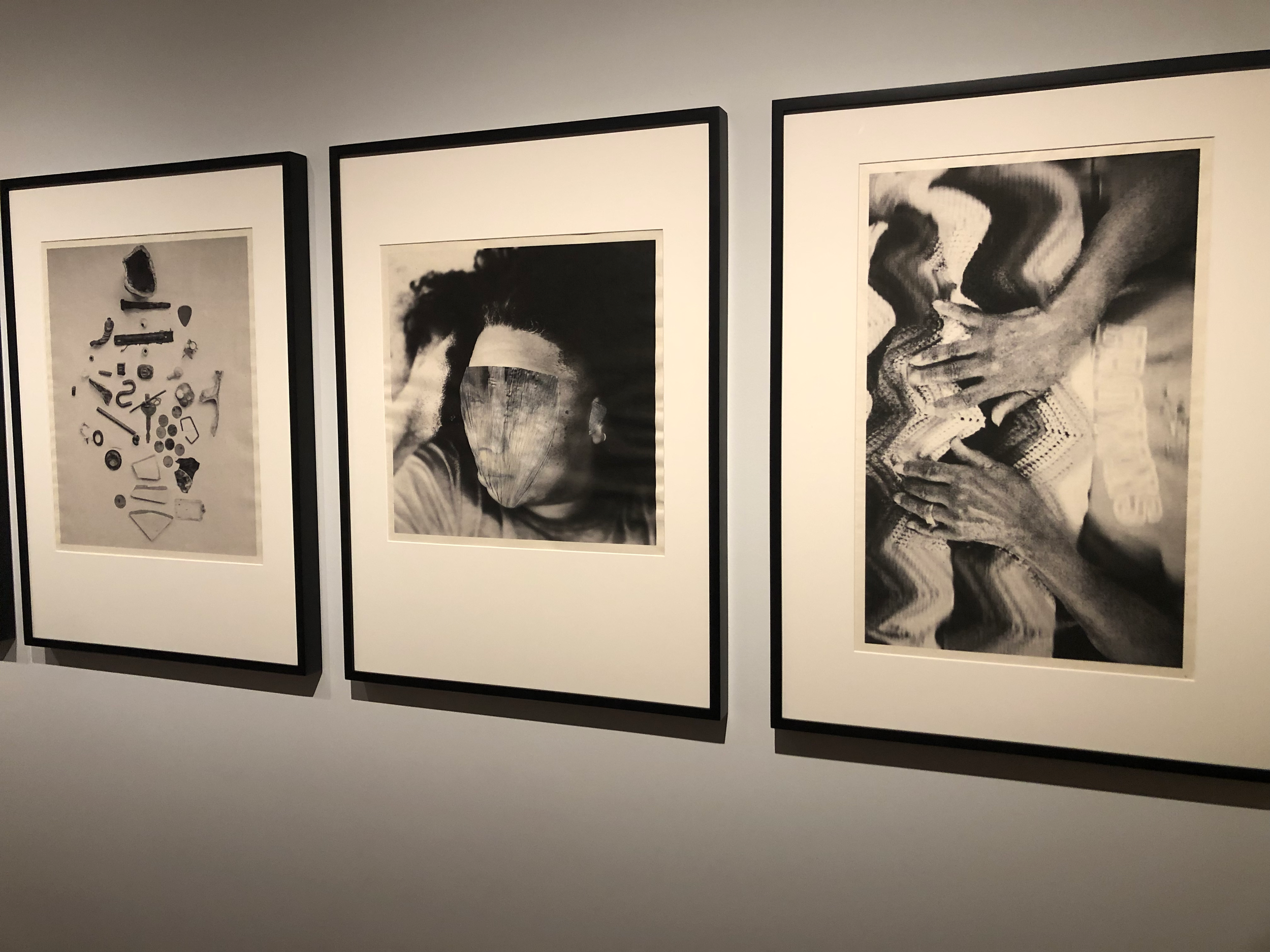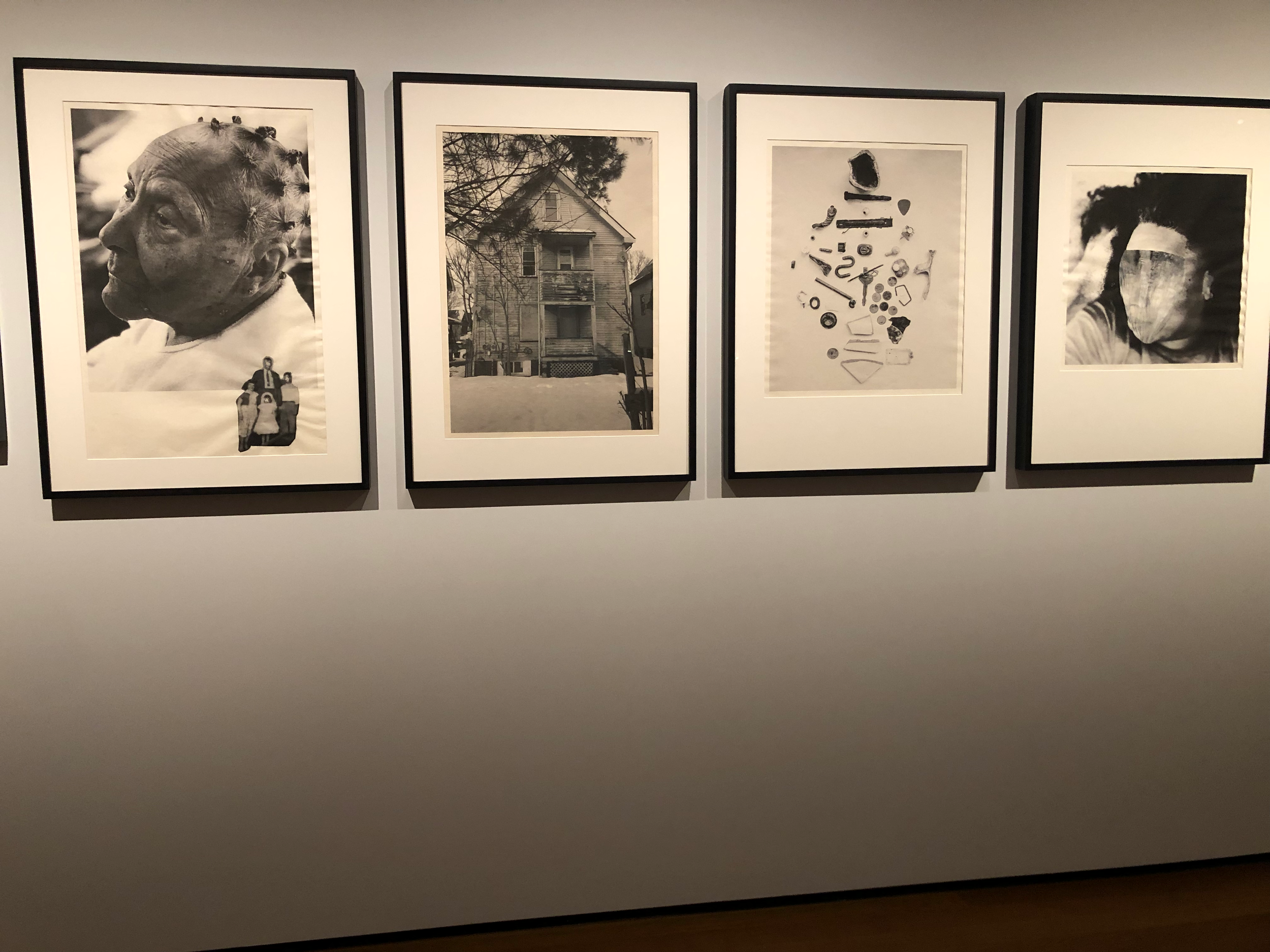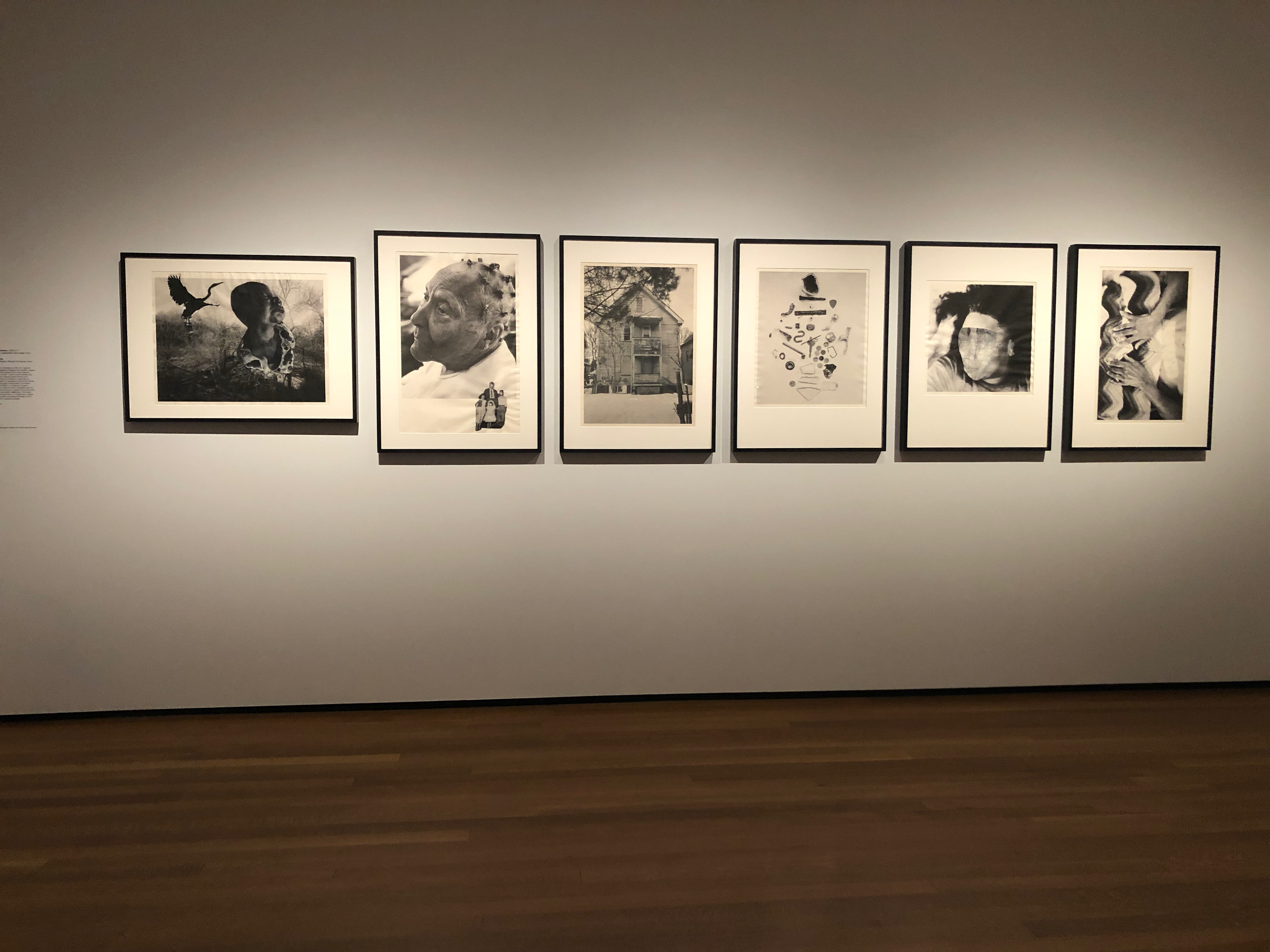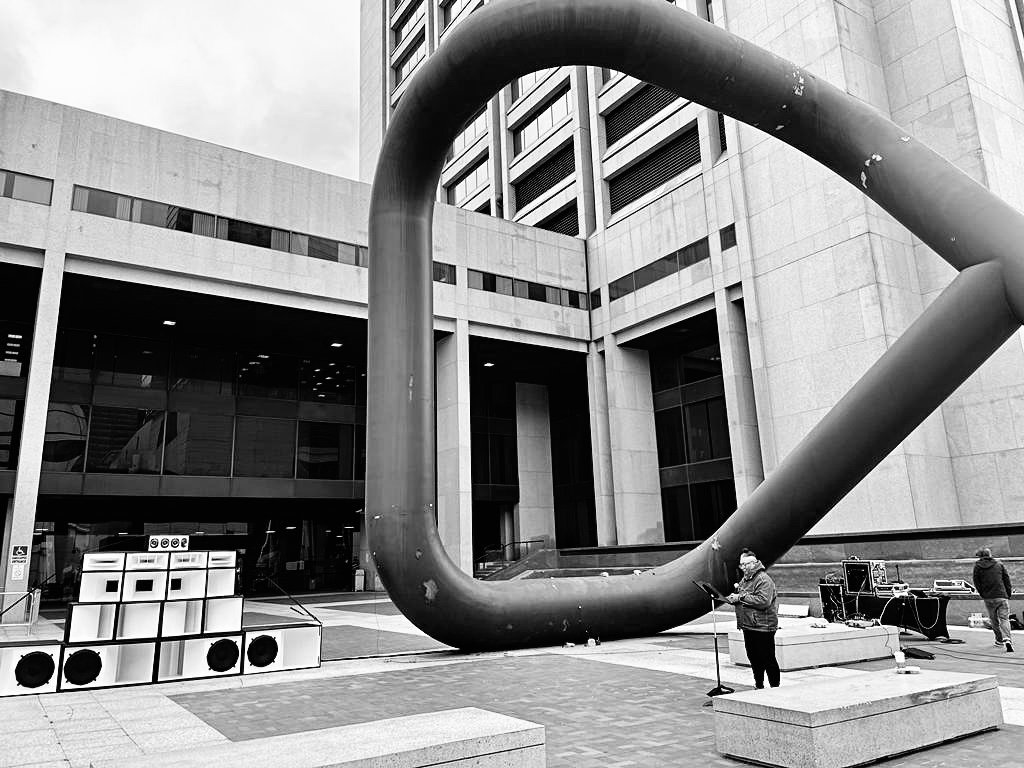Ken’nahsa:ke/Khson:ne: On My Tongue, On My Back (Family Tree)
Mixed media construction with Black Body Bag, 2018
Body Bag (2018), Art Book
SPACES Gallery 7.14 thru 9.30
In 1984 the remains of Estherline Robinson were discovered by a film crew scouting location for a horror film in East Cleveland—she died in 1979. Her body was perceived as a white female body and caused a stir due to the defunct funeral home’s black ownership and clientele. This work is an examination of inter-generational trauma and the capacity for reconciliation after years of structural and interpersonal violence—;the impact of removal. The remains of Estherline Robinson were interned in Westwood Cemetery in June of 2018 by her great-grandchild, M. Carmen Lane.
Original Composition: "Our Relatives" by Emmy nominated singer/songwriter Jennifer Elizabeth Kreisberg (Tuscarora), hand drum and vocals www.jenniferelizabethkreisberg.com
Chopa/Ellegua Till: The Nigger Who Did The Talking (2018)
Mixed media construction with Water Recovery Body Bag
A Color Removed/SPACES Gallery 7.14 thru 9.30
On August 21, 1955 Emmett Louis Till arrived from Chicago, Illinois to Money, Mississippi. Seven days later his body was dumped into the Tallahatchie River after being lynched by white men who accused him of “wolf-whistling” at a white woman. He was fourteen years old at the moment of death—weighed down by a fan. Three days after the dumping, his naked body was removed from the river after two boys discovered it while fishing. The white woman had lied. This work is an examination of the agency of Spirit within the lived experience of black bodies under siege navigating both the natural and constructed world—the medicine to soothe the dissonance; necessity of contact with the ancestors in the face of a constant molesting of the meaning of the black experience—here/now, then.
Akhsó (Grandma): This Is A New Experience, 2019 & Skin Hunger/the Artist As Caregiver, 2018
—Black & white iPhone image, printed on vinyl; mixed media construction
—Sound Piece (originally published Anomaly, Issue 27)
In The Presence of Absence/EFA PROJECT SPACE 3.27 thru 5.11
This site specific intervention of the sacred examines the in-between; the before and after death through the experience of the artist’s grandmother, Vivian Murphy. In her own words knowing “you’re about to pass away” is a new experience. Here, the artist explores the intersections of race, class, gender and the possible meanings associated with the taking of a last breath in a black or brown body aged almost a century in a constructed environment that renders harm through invisibility. Closing out the life you have lived in your raced and gendered body is a ceremony of becoming—a return to human being.
Advanced Decay (Where You At Girl), 2019
mixed-media construction; dimensions variable
Rooms to Let CLE 5.18 thru 5.19
This site specific sacred space investigates the relationship between vacant or abandoned homes and missing and murdered Black and Indigenous women; exploring the intersections of land, place and the many silences between the viewer and black and brown gendered bodies--the number eleven functions as a form of reverence and remembrance.
AMALA: She Could Not Stay (In Their Black Bodies), 2018 & Birth In The Mourning, 2020 exhibition-in-stasis
—mixed-media construction with FEMA body bags; dimensions variable & sound piece
Praxis Fiber Workshop Gallery 2.7 thru 2.25
This site specific sacred space functions to illuminate the dimming of black life in a city and the interruption of a flourishing environment due to interventions of a constructed system that utilizes the inventions of race to disrupt the experience of being human. Using gesture of the Indigenous technology of the cradleboard to north hold and to root, this work visualizes data using elements from the natural world. Our knowledge hidden in the land, built over by settler colonialism is, at the core of a reality that efforts to fix the problem of black babies dying.
M. Carmen Lane, sound piece (2020); original composition Jennifer Elizabeth Kreisberg; illustration Katherine Freer
Some Notes On Racism During A Global Pandemic, 2020 for Daniel
—sound piece; original composition, “Center the Medicine,” by Jennifer Elizabeth Kreisberg (Tuscarora); illustration & animation by Katherine Freer
This video poem explores the intersection of race, police violence, whiteness and the complex histories that contribute to systemic violence—created in response to the murder of George Floyd.
This House (Is A Microcosm), 2020
—digital print on Japanese kozo paper
11808 Cromwell Avenue was slated for demotion, This house was acquired by the artist to reimagine its use as a socially engaged urban retreat and residency space in the Buckeye-Shaker neighborhood. The image depicts the structure prior to being renovated.
Built in 1915, its original occupants were a newly migrated family from Hungary named “Takacs.” From what could be surmised by the historical record, a male descendant continued to occupy this structure until his death. His widow remarried and the ownership transferred to a man with the Polish name “Brzezinski.” In 1975, he still owned the property, the tail end of white flight. By the 1990’s through the mid 2000’s, African-American families lived and lost in this space, their surnames are “Knox” and “Wade.”
The Cuyahoga Land Bank became the owners of the property and through a defunct grant opportunity, Neighborhood Housing Services (now merged with the Cleveland Housing Network) partnered with the artist to renovate the home.
This work is a gesture of what the artist calls “place reclamation,” that is, rather than the use of arts and culture as an intervention of erasure, the project efforts to expand, reveal and excavate the complex histories of a place through arts ability to tell--a catalytic practice.
Compound Effigy & The Names (2021)
(for Ma’hkia Bryant) video, mixed-media installation (river water, beans, sinew, corn) and sound work; dimensions variable
SHIFT/ Riffe Gallery, 7.31 thru 10.9 2021
This site specific installation examines the function of place and architectures that have served as sites of protest in relationship to the constructed environment built upon the natural world. This work encourages a shift from the colonial to a place based subjectivity, acknowledging the Indigenous and Black communities that made home before Columbus and after—a gesture to engage the viewer through spatiality, responsibility and care.
Image taken by Rita Knight-Gray
Children, Wade In! (2021)
—triptych; digital print, wooden door, sand, sinew
CONVERGE/Artist Archives of the Western Reserve 8.26 - 10.16 2021
This work is a gesture to acknowledge and honor Cleveland’s underground Black ballroom culture and the African-American queer histories that are hidden or erased by time and place. The Allen-Sullivan House, once known as “The Colosseum,” was one site that held “house balls” and served as a Black queer after-hours space in the city. The images depict the locations of Black gay joy and creative expression and are the final images of the site before its demolition in July 2021.
Original Instructions (2022)
—six digital prints on Japanese kozo and sound, “It Will Be Moved Again”
Picturing Motherhood Now/Cleveland Museum of Art 8.12 - 3.13 2022
A commissioned work expanding “This House Is A Microcosm” into a visual narrative depicting the birth of the artist-run space, “ATNSC: Center for Healing and Creative Leadership” founded by the artist.
(í:se) Be Our Guest/Stolen (2022)
video work, screen prints and text based work; dimensions variable
Brattleboro Museum & Art Center 3.12 thru 6.12, 2022
This nine print series investigates the impact of fugitive migration and place through the personal histories of the artist’s family—the first people of color to inhabit Cleveland Heights, Ohio in 1923 and the displacements that followed after forced removal by their white neighbors.
We Will Remain (Portal Face), 2022
sound work; written + spoken by M. Carmen Lane; composed by Jennifer Elizabeth Kreisberg; vocals: M. Carmen Lane + Jennifer Kreisberg; oud improvisations: Tarik Kezelah; water drum: Jennifer Elizabeth Kreisberg
Front Triennial, 2022
This work was commissioned by artist Joe Namy as part of several activations of an Isamu Noguchi sculpture sited at the Cleveland Justice Center. The work was performed live with its sound transmitted through the Noguchi sculpture “Portals” as part of the public performance during the closing weekend of FRONT.
Migrations (My Great-Grandmother Was A Republican), 2022
solo exhibition
Farmer Family Gallery/Ohio State University (Lima), October 27th thru December 8th, 2022
This exhibition explores the multiple meanings of place—erasing the binaries of urban/rural, white/black through investigating early Afro-Indigenous communities in Northern Ohio.
The Jazz Temple Project (2019 to Present; on-going), Archival Storytelling
“Somebody: Mourning At The Temple,” is a digital archive documenting the history of The Jazz Temple, a coffeehouse and jazz club located in the historic Mayfield Triangle of University Circle and is currently home to the Museum of Contemporary Art Cleveland. The club was destroyed by a racially motivated bombing in 1965.
Calling Out After Slaughter (2015), Poetry
second edition forthcoming 2024-25
"Here is a new romantic writing peppered with cultural knowing and spiritual ceremony. Here is a bitter medicine that will cure y(our) ills. M. Carmen Lane delivers gut punches with succinct verses in history lessons on the page that breathe. This writer gifts us insights in verse; observations that state 'being human' is hard work, oppression is expensive and life is not life, without risk."
Janet Marie Rogers (Mohawk/Tuscarora)
Victoria Poet Laureate
2012-2014
CoverArt: Fox AC Spears (Karuk)
